See Photos of Queen Elizabeth's 1994 State Visit to Russia
The Queen's trip to Russia, which followed Boris Yeltsin's trip to the UK, is depicted in season five of The Crown .
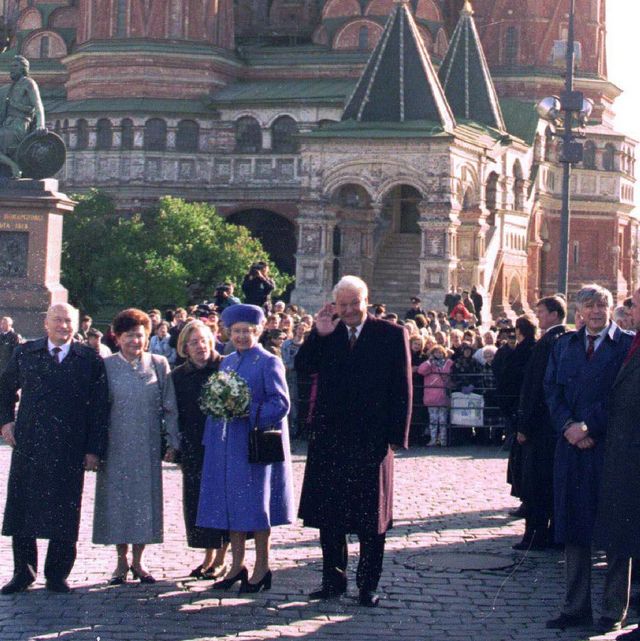
Here, see all the photos of Queen Elizabeth's 1994 trip to Russia, as shown on The Crown :
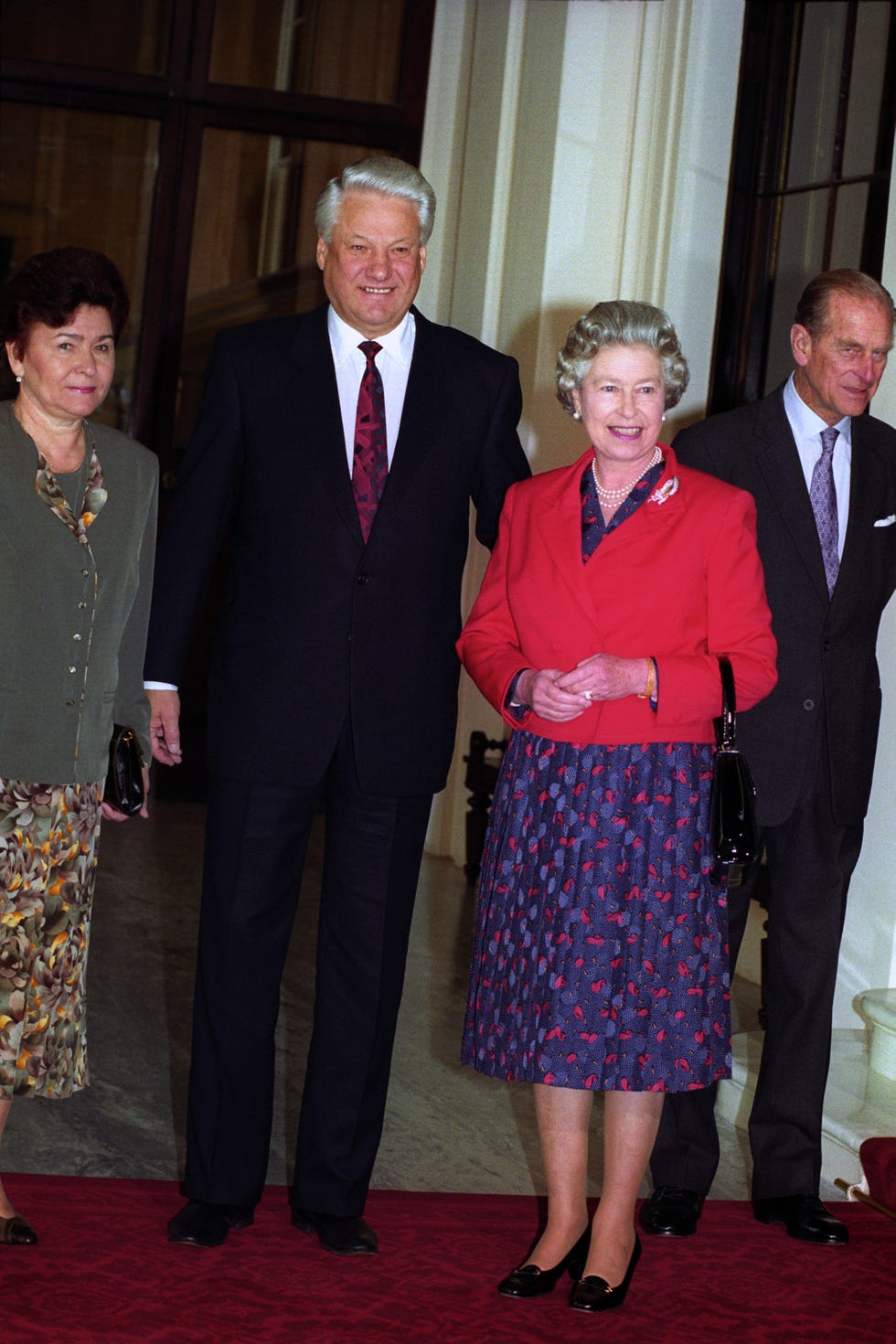
This is not from the State Visit to Russia, rather this is when Yeltsin visited the UK two years prior. Pictured are Naina Yeltsin, President Boris Yeltsin, Queen Elizabeth, and Prince Philip at Buckingham Palace.

State Visit, 1994
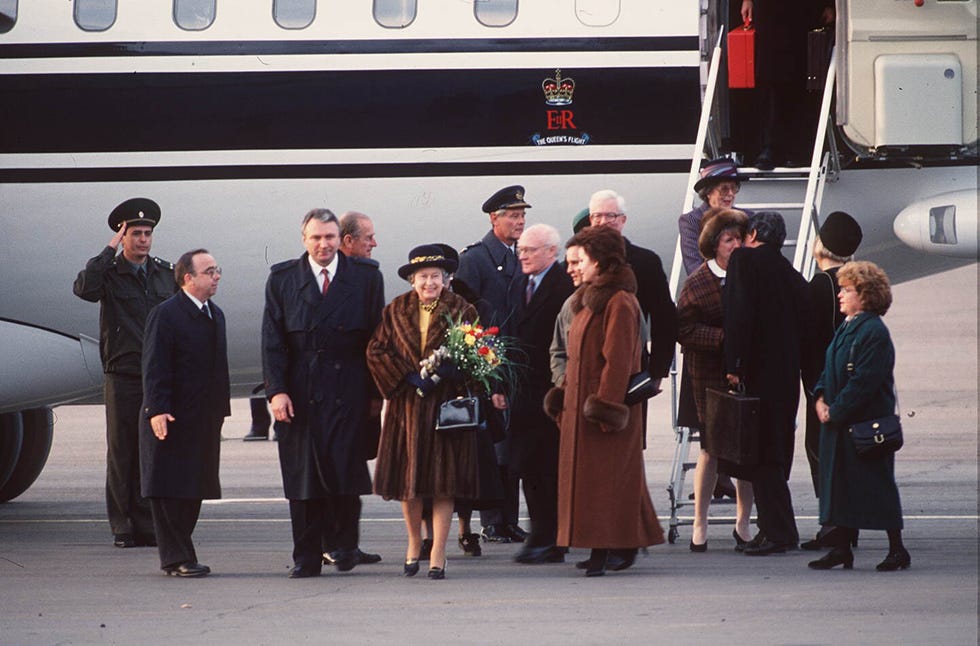
Queen Elizabeth is pictured arriving in Moscow, wearing a glamorous fur coat.
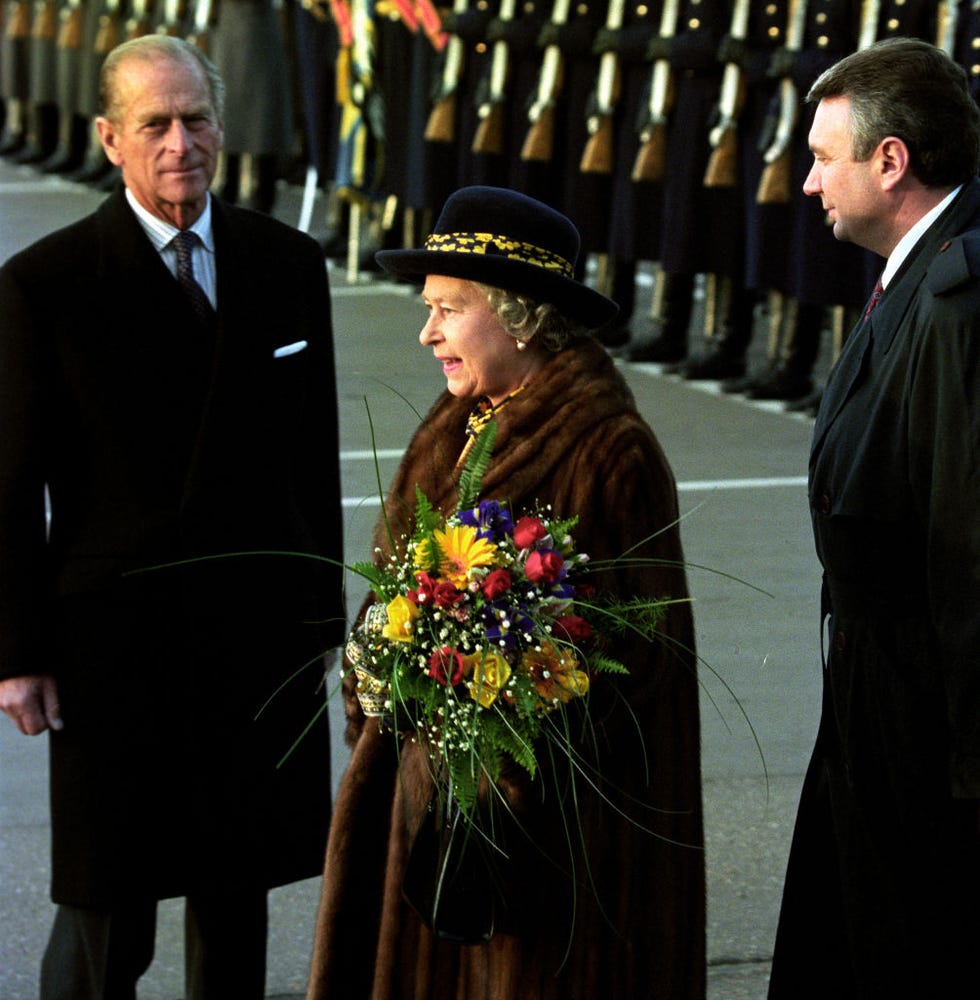
A close-up of the Queen and Prince Philip upon their arrival in Russia.
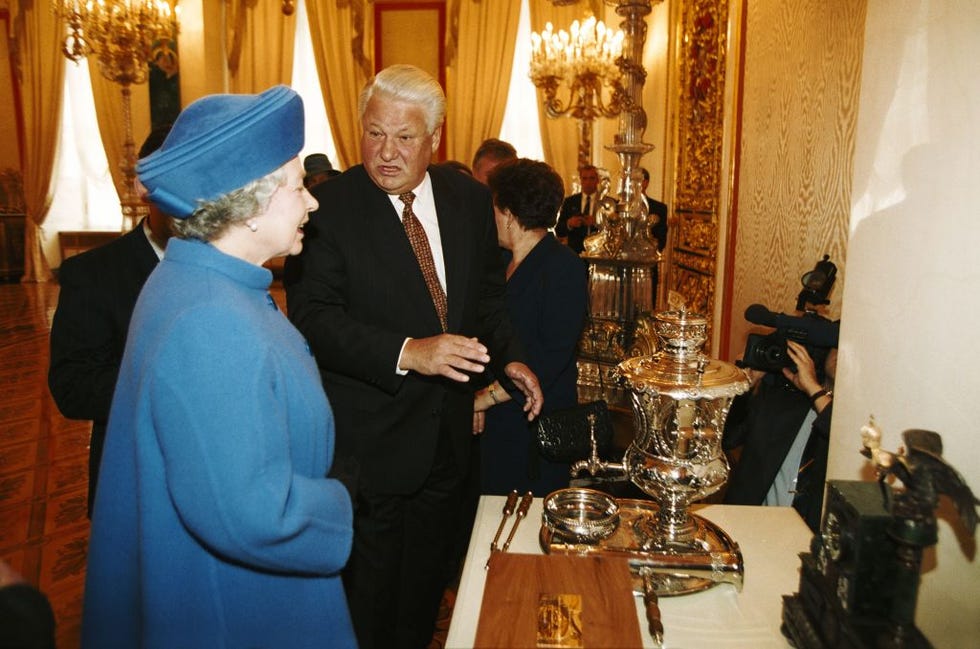
Throughout the trip, she was accompanied by Boris Yeltsin, who served as president of Russia from 1991 to 1999.
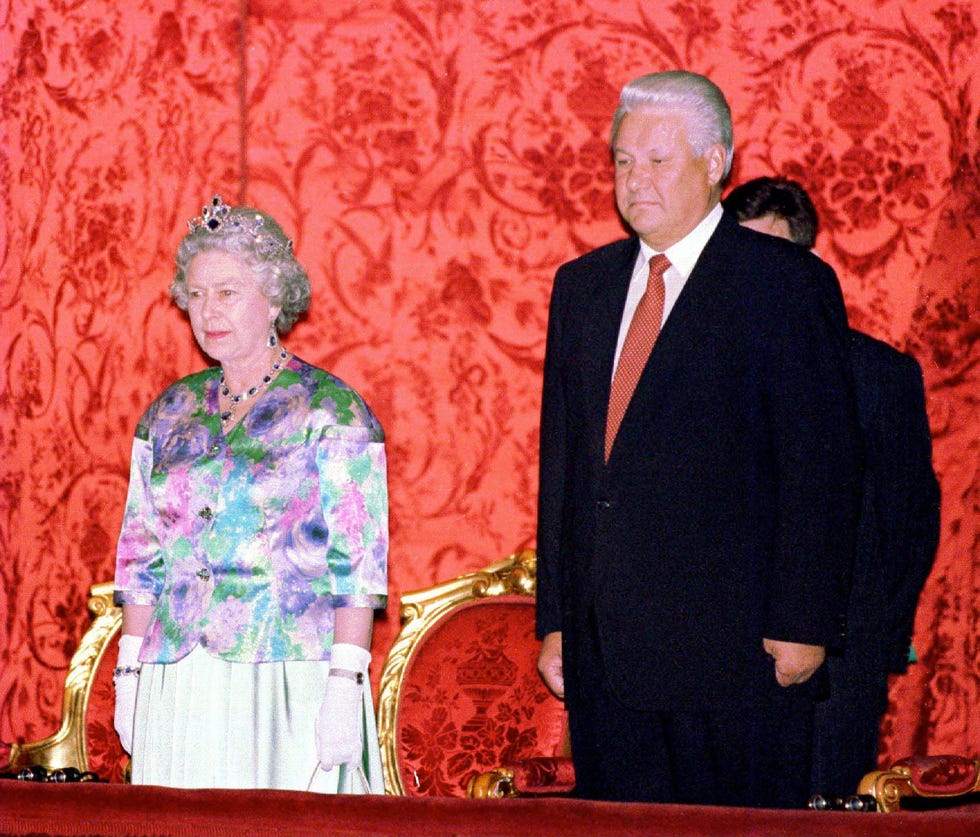
Queen Elizabeth was not the first British royal to visit Russia. In 1973, Prince Philip and Princess Anne attended a horse eventing competition in Kyiv, then part of the Soviet Union, and in 1994, Prince Charles visited Saint Petersburg.
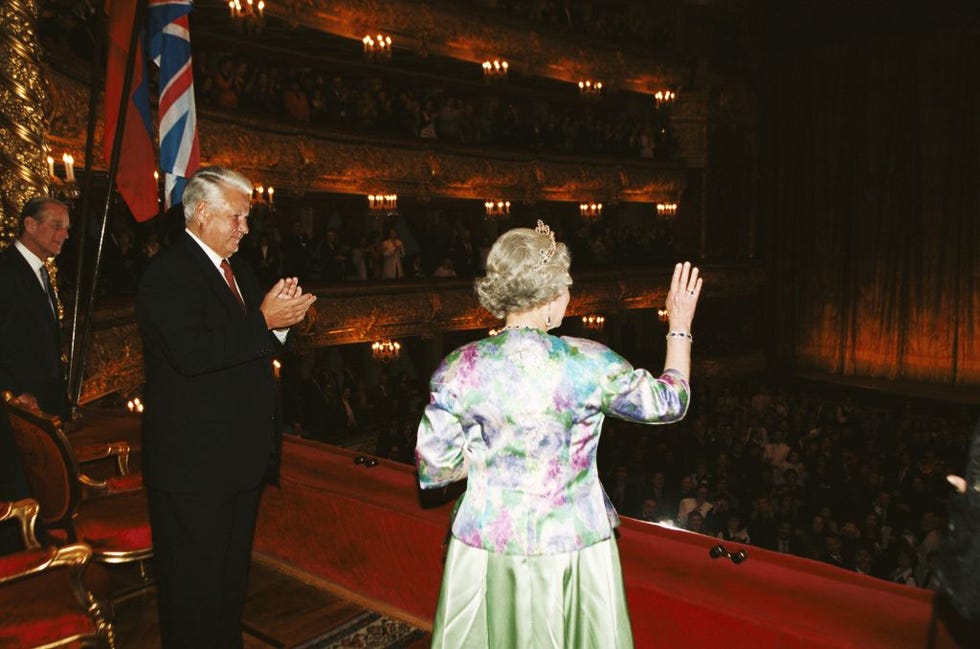
Queen Elizabeth and Prince Philip stayed in the Kremlin as guests of Yletsin.

Here, the Queen and Yetsin are pictured at the Bolshoi theatre.
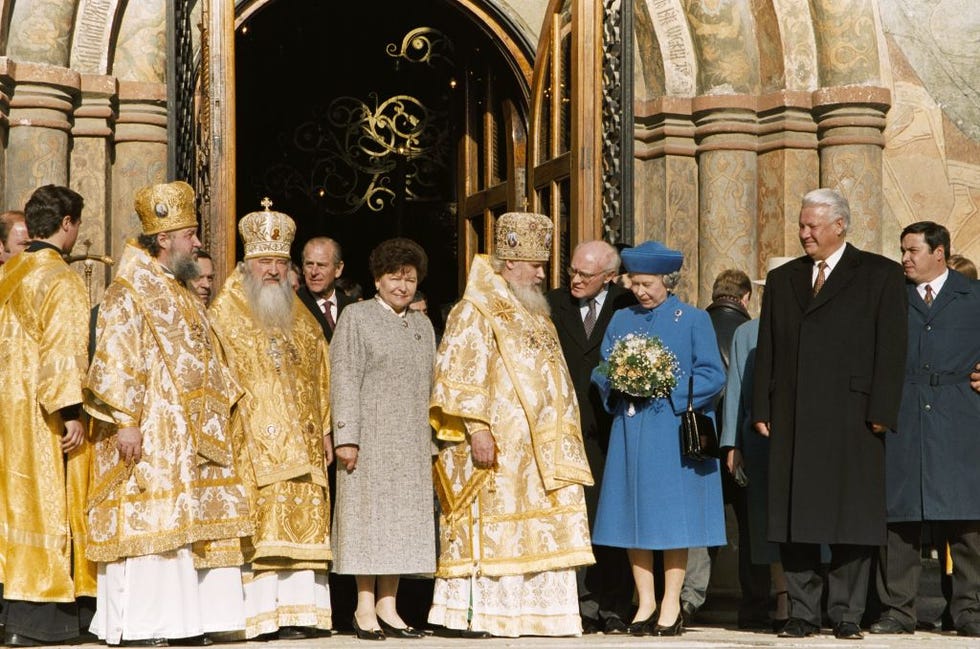
Queen Elizabeth met Patriarch Alexius II and mayor of Moscow Yury Luzhkov; they are pictured here outside Saint Basil's Cathedral.
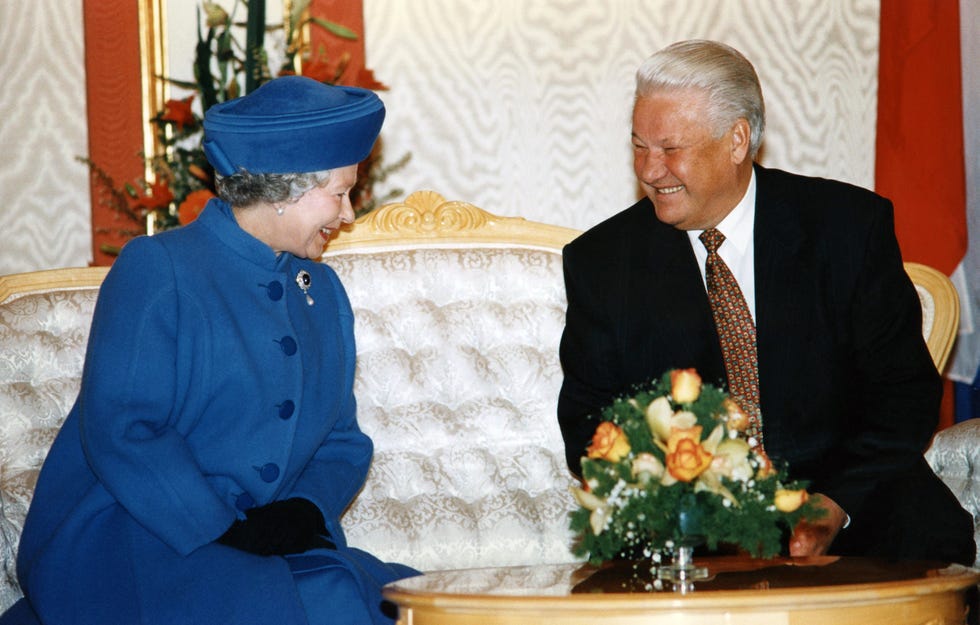
"For Russia, this visit is the utmost recognition that our country is on the road to democracy," Yeltsin told reporters of the Queen's visit.
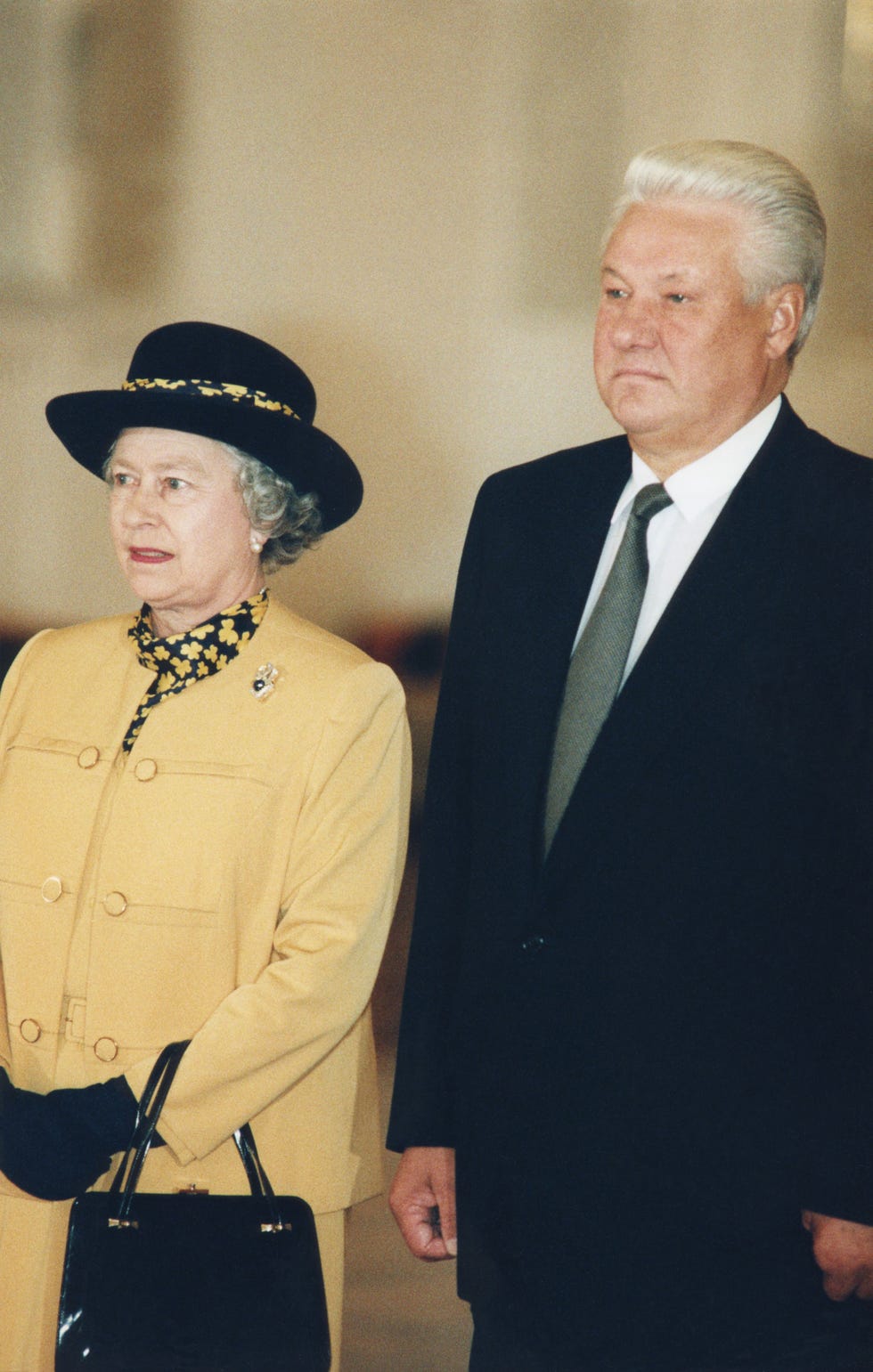
As The Crown shows, the murder of Tsar Nicholas II and his family was a reason why the Queen had yet to visit Russia. Her grandfather, King George V, was Nicholas's first cousin.
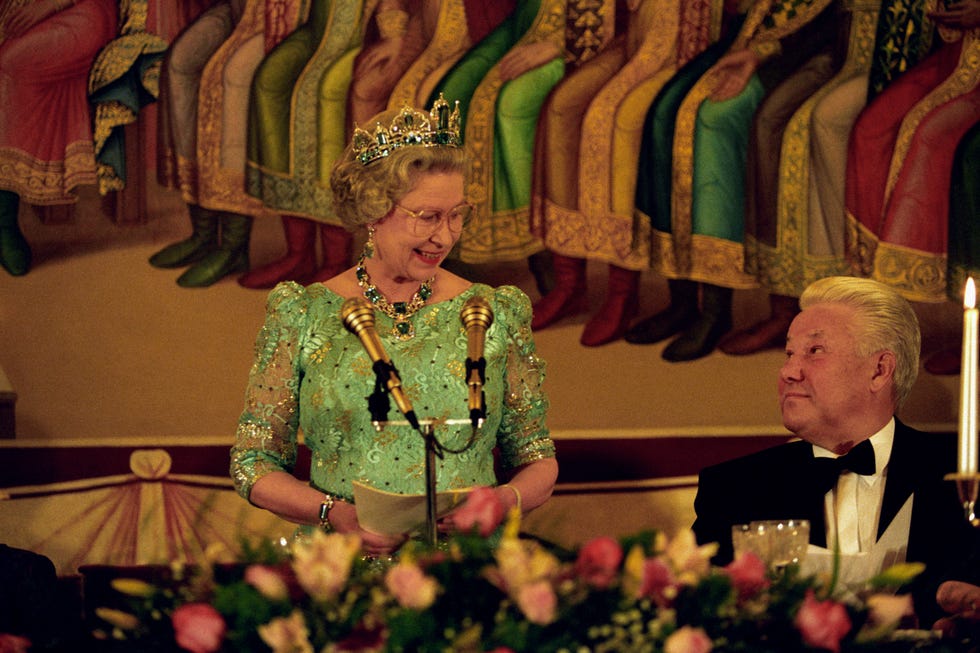
"You and I have spent most of our lives believing that this evening could never happen. I hope that you are as delighted as I am to be proved wrong," Queen Elizabeth said to Yeltsin at a state banquet.
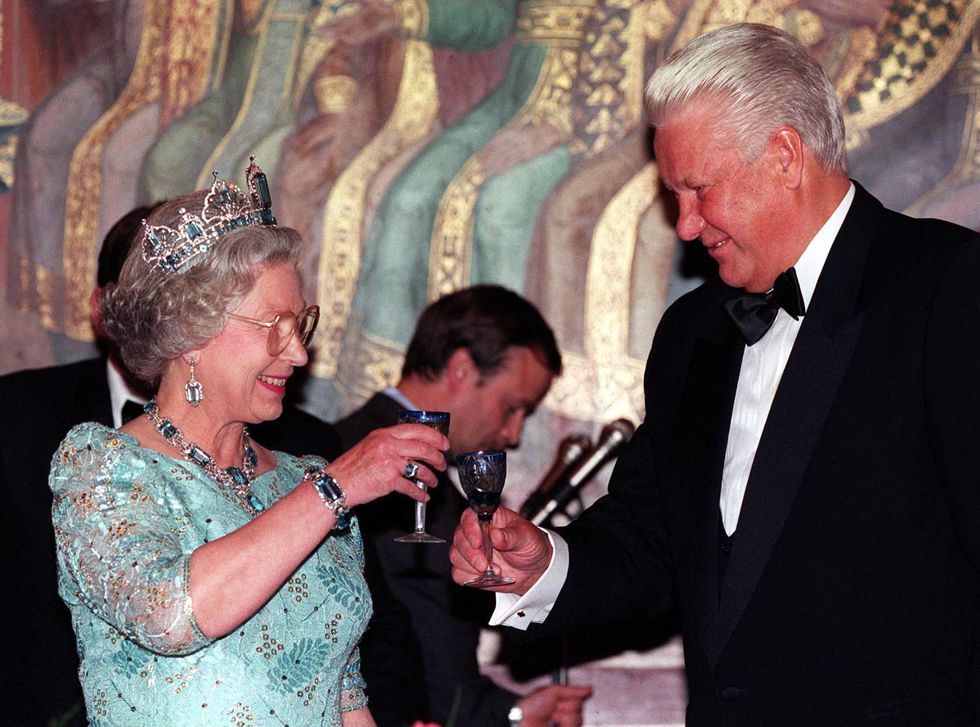
The two toasted at the banquet.
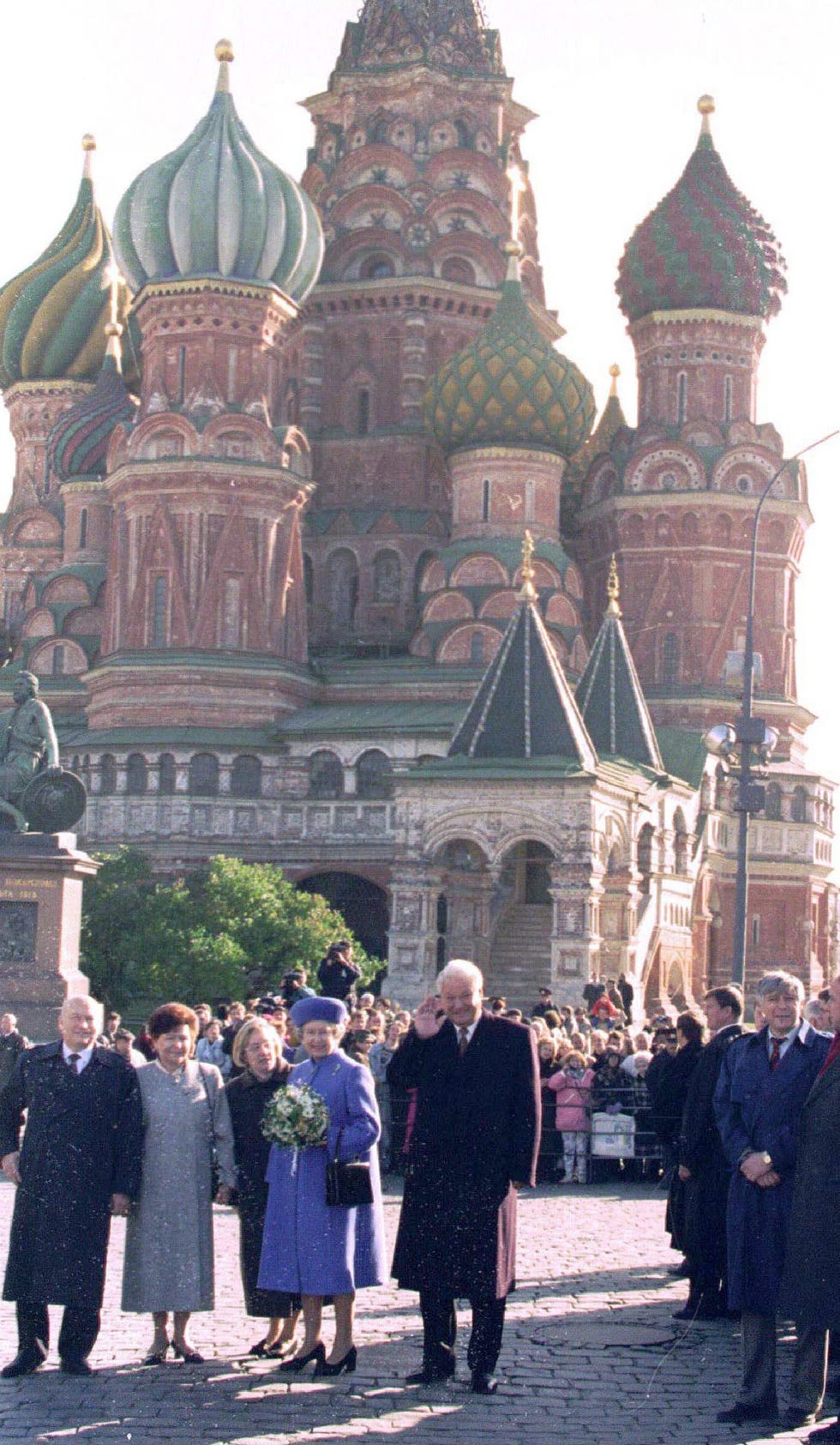
Queen Elizabeth toured Moscow during her four day trip, including visiting the famous Red Square.
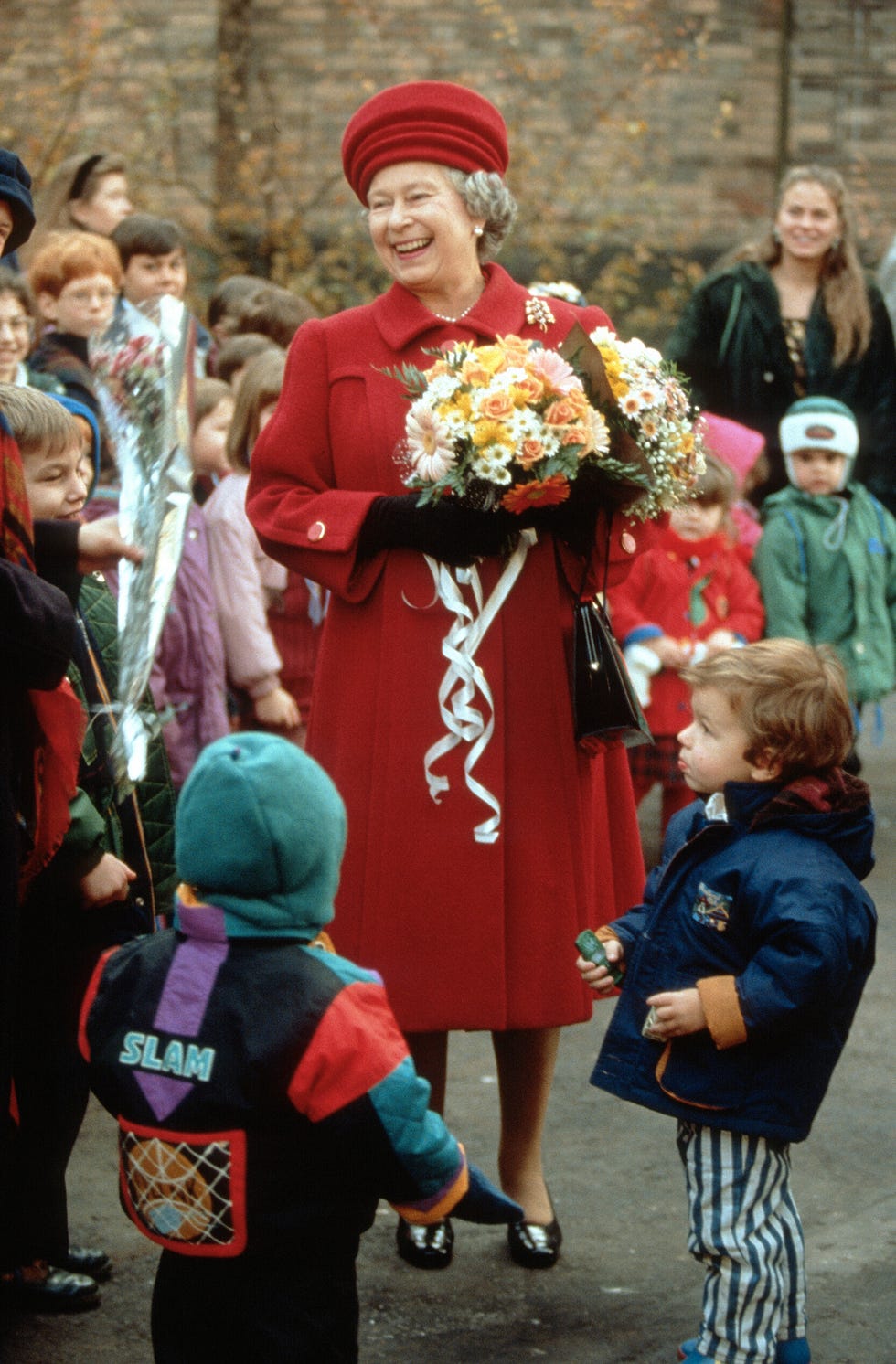
She also met Russian children.
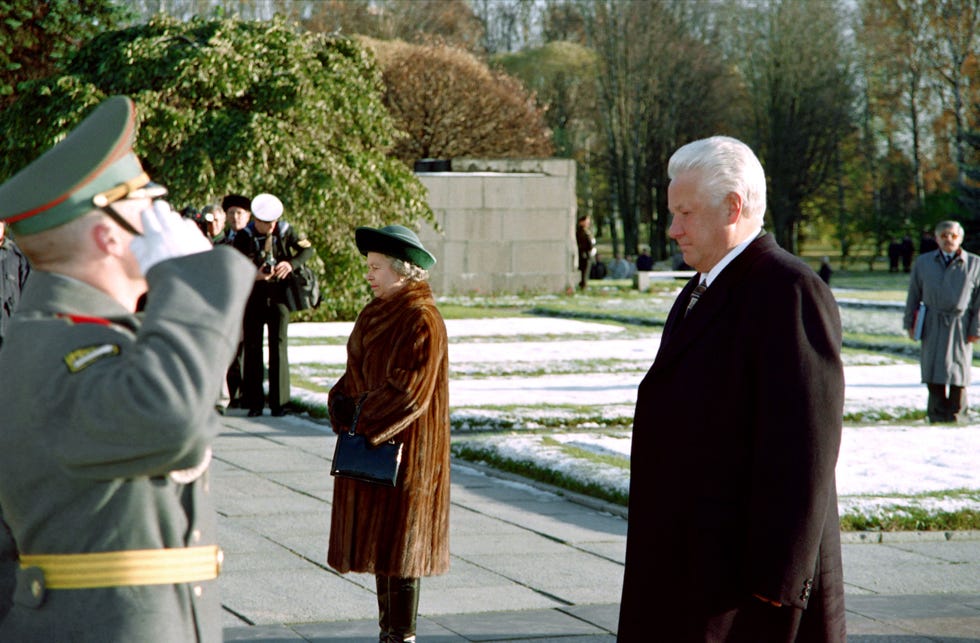
There were more formal events during the trip, too; Queen Elizabeth and Yeltsin attended a ceremony at the Piskarevskoye cemetery, a WWII memorial in St. Petersburg.
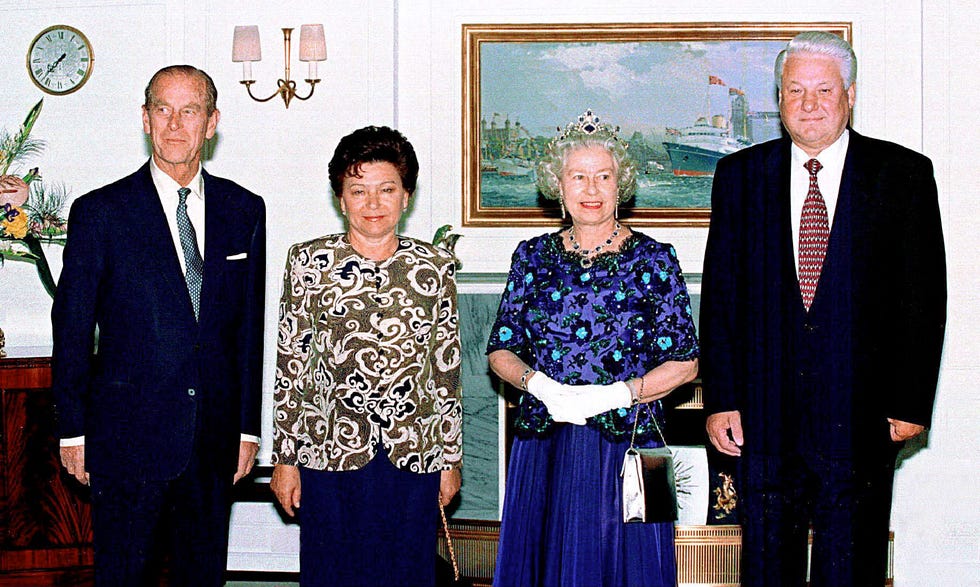
During the trip, Prince Philip and the Queen hosted the Yeltsins on board the Royal Yacht Britannia for a banquet.
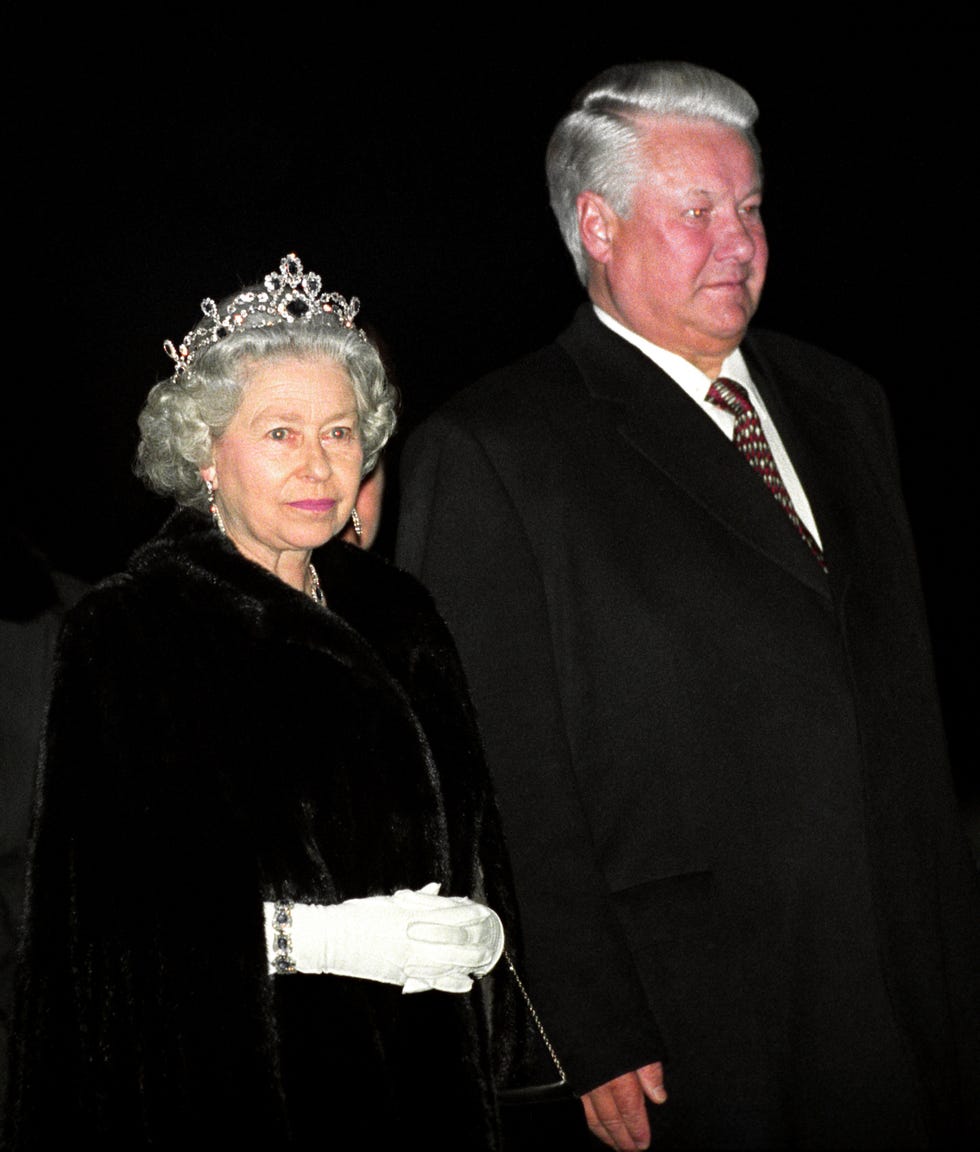
During her Christmas address two months later, Queen Elizabeth reflected, "I never thought it would be possible in my lifetime to join with the Patriarch of Moscow and his congregation in a service in that wonderful cathedral in the heart of the Moscow Kremlin."
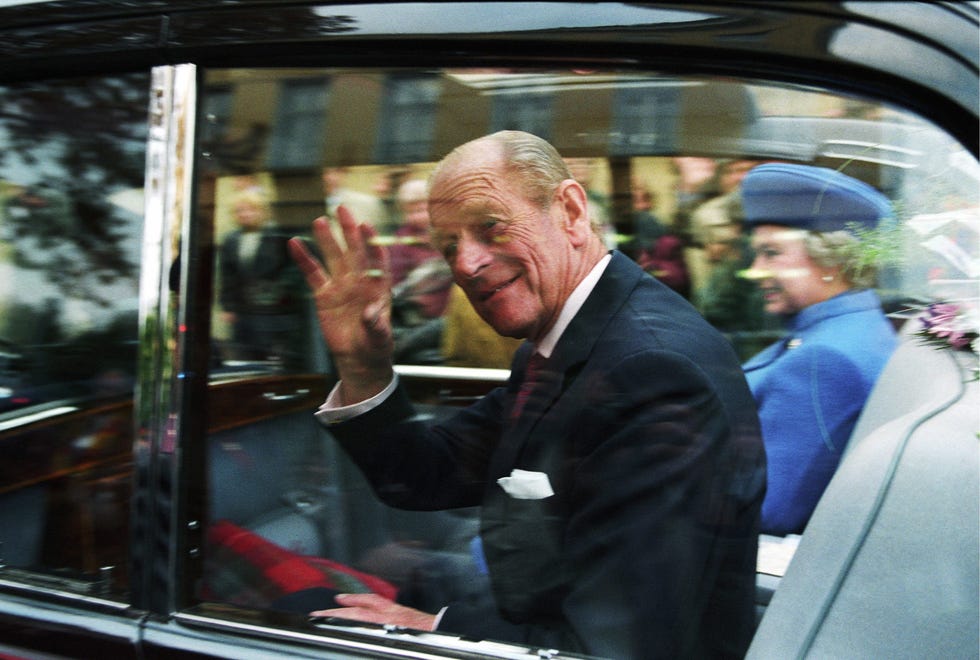
Queen Elizabeth would not return to Russia; Prince Philip returned once more, in 1995, as president of the World Wildlife Fund.
Emily Burack (she/her) is the Senior News Editor for Town & Country, where she covers entertainment, culture, the royals, and a range of other subjects. Before joining T&C, she was the deputy managing editor at Hey Alma , a Jewish culture site. Follow her @emburack on Twitter and Instagram .
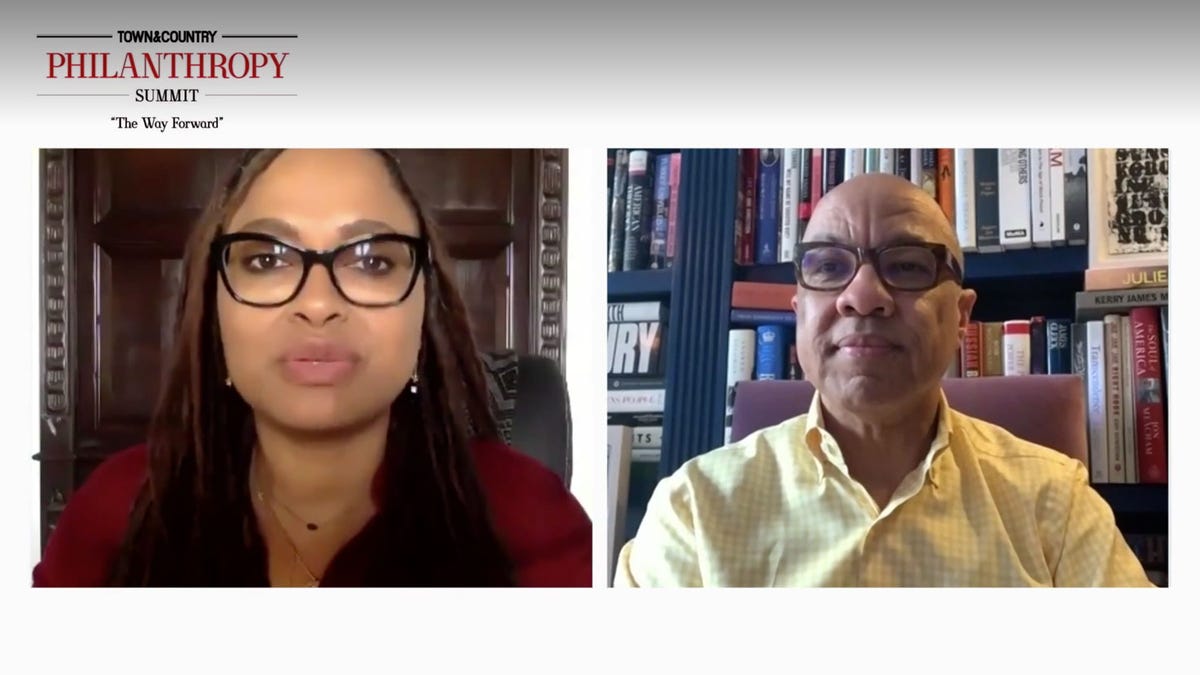
@media(min-width: 40.625rem){.css-1jdielu:before{margin:0.625rem 0.625rem 0;width:3.5rem;-webkit-filter:invert(17%) sepia(72%) saturate(710%) hue-rotate(181deg) brightness(97%) contrast(97%);filter:invert(17%) sepia(72%) saturate(710%) hue-rotate(181deg) brightness(97%) contrast(97%);height:1.5rem;content:'';display:inline-block;-webkit-transform:scale(-1, 1);-moz-transform:scale(-1, 1);-ms-transform:scale(-1, 1);transform:scale(-1, 1);background-repeat:no-repeat;}.loaded .css-1jdielu:before{background-image:url(/_assets/design-tokens/townandcountrymag/static/images/diamond-header-design-element.80fb60e.svg);}}@media(min-width: 64rem){.css-1jdielu:before{margin:0 0.625rem 0.25rem;}} The Crown @media(min-width: 40.625rem){.css-128xfoy:before{margin:0.625rem 0.625rem 0;width:3.5rem;-webkit-filter:invert(17%) sepia(72%) saturate(710%) hue-rotate(181deg) brightness(97%) contrast(97%);filter:invert(17%) sepia(72%) saturate(710%) hue-rotate(181deg) brightness(97%) contrast(97%);height:1.5rem;content:'';display:inline-block;background-repeat:no-repeat;}.loaded .css-128xfoy:before{background-image:url(/_assets/design-tokens/townandcountrymag/static/images/diamond-header-design-element.80fb60e.svg);}}@media(min-width: 64rem){.css-128xfoy:before{margin:0 0.625rem 0.25rem;}}
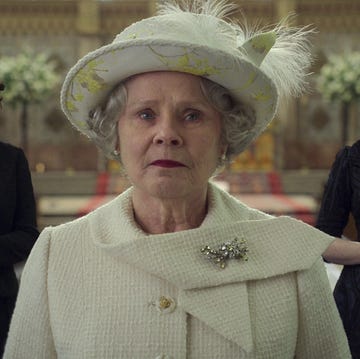
Elizabeth Debicki Wins SAG Award
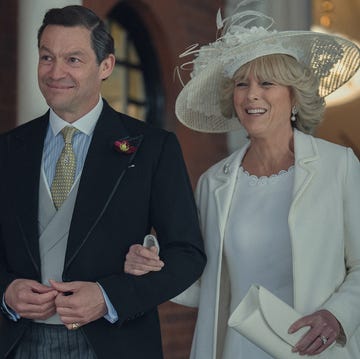
Dominic West Stayed in Bed After 'The Crown'
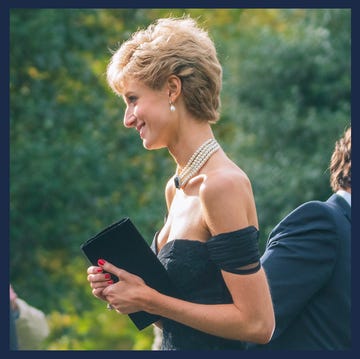
The Crown's Costumes, Props, and More at Auction

Elizabeth Debicki Stuns in Dior

Elizabeth Debicki's Best Red Carpet Looks
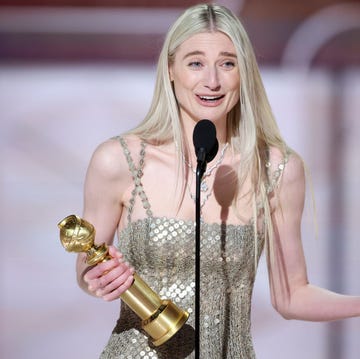
Elizabeth Debicki Wins Golden Globe

Jonathan Pryce Apologized to Princess Anne
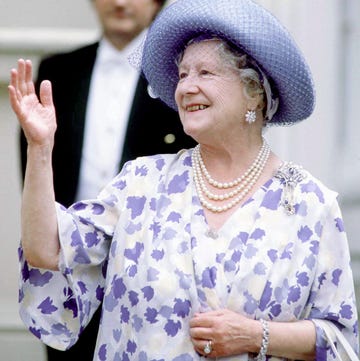
All About The Queen Mother's Pearl Ring
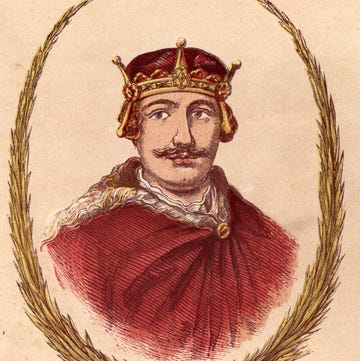
Why Is King William II's Death in 'The Crown'?
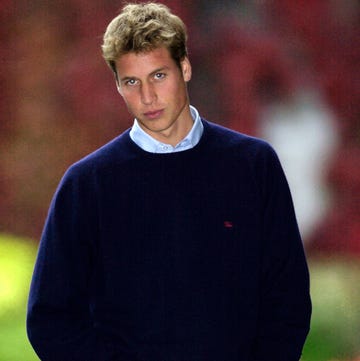
A Look at Prince William's Early 2000s Style

The Queen's Toast at Charles & Camilla's Wedding
WATCH: Queen Elizabeth was the first British monarch to visit Russia
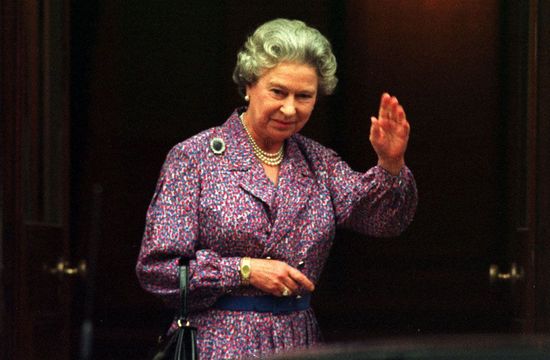
Queen Elizabeth II, photographed in 1993. RollingNews
On Oct 17, 1994, Queen Elizabeth II became the first ruling British monarch to set foot on Russian soil.
As the eyes of the world are on Russia and the invasion of Ukraine, which has caused I migration of refugees unlike anything seen since World War II, we thought it interesting to look back at the October 1994 of Queen Elizabeth II to the Kremlin, by invitation of the then Russian President Boris Yeltsin.
In 1994 the Queen made a three-day visit to Russia. Three years before had seen the dissolution of the Soviet Union, when Yeltsin took office. His hope was that Her Royal Majesty's visit would strengthen the trade relationship with Britain and the Western World.
Yeltsin's spokesman, Vyacheslav Kostikov, said at the time "We realize that the British queen would never have visited a Communist country."
- History of "God Save the King", Britain's National Anthem
Personally, 1994 was also a difficult time for the Queen personally as her son, Prince Charles, had separated from Princess Diana, just two years earlier. A biography of the Prince, by Jonathan Dimbleby, had caused a media frenzy over comments made by Charles with relation to his relationship with his mother and father, Prince Philip.
The Queen and Prince Philip landed in Moscow on Oct 17, 1994. They were then taken to the Kremlin where they were greeted by Yeltsin and his wife, Naina. The Royal pair were also treated to a special performance of the Bolshoi Ballet.
The climax of the tour was a state banquet given on the final evening by the Queen aboard the royal yacht Britannia which had sailed to St. Petersburg to meet the royal party.
They left Russia on Oct 20 and broke the journey home by visiting Finland.
Since 1994 some members of the Royal family have visited Russia, including Princess Anne. She visited in 2016 to mark the 75th anniversary of the first Arctic convoys from the United Kingdom during World War II. Prince Charles also Russia in 2003. This visit resulted in a return invitation to President Vladimir Putin to visit Britain later that year.
Check out some AP footage of the Queen having dinner at the Kremlin:
Related: Queen Elizabeth II
BHT newsletter
You may also like.
- Most Recent
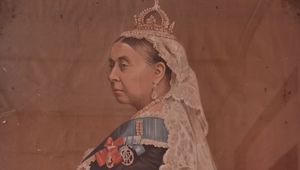
Is this the last-known footage o...
On this day in 1819, Queen Victoria was born. This footage of Queen...

What were Queen Elizabeth's hobb...
Just what were Queen Elizabeth's hobbies?

The spiritual claims and legends...
Have more spiritual claims and legends attached to Glastonbury than...

Wallis Simpson and the royal tit...
This moment in royal history happened all because Edward VIII abdic...
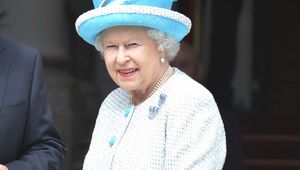
Why Queen Elizabeth II is in the...
Queen Elizabeth II is a Guinness Book of Records seven times over b...
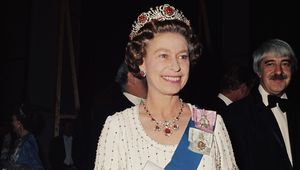
Why do only some Royals wear tiaras
Have you ever wondered why only some royals wear tiaras and others ...

An expert's guide to Scottish slang
When it comes to slang in the United Kingdom, it has to be said tha...
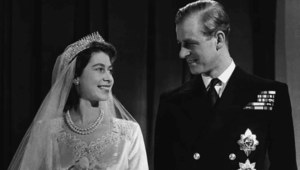
Surprising facts about Queen Eli...
On November 20, 1947, the world witnessed a fairytale come to life ...
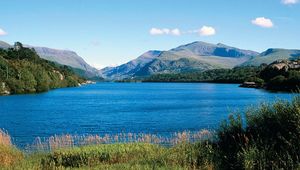
BHT's ten greatest natural wonde...
Some truly magical spots around Britain where the wonder of the nat...
The Queen of travel
Queen Elizabeth II 1926 - 2022
Queen Elizabeth II leaves Fiji during a royal tour in February 1977. Serge Lemoine/Getty Images
The Queen of travel Journeys of a lifetime
By Francesca Street and Mark Oliver, CNN September 13, 2022
S he was traveling the moment she ascended to the throne, and for much of the next seven decades, Queen Elizabeth II criss-crossed the world. Newly married and still just a princess, Britain’s future monarch was in Kenya with husband Prince Philip in February 1952 when she learned of her father’s death and her new regal status.
During her reign she would visit more than 120 countries, witnessing first-hand the revolutions in global travel that shrank the world as her own influence over it diminished.
The Queen lived through the advent of the Jet Age, flew supersonic on the Concorde, saw regimes change, countries form and dissolve, the end of the British Empire and the rise of globalization.
Here are some of the most memorable travel moments from her 70 years as monarch.
November 24-25, 1953
Less than six months after she was crowned at Westminster Abbey in London, Queen Elizabeth set off on her travels again. Her debut official state trip was an epic six-month tour of the Commonwealth -- the alliance of nations which were once British colonies. Traveling by air, sea and land she visited several countries, accompanied by her husband, Prince Philip, the Duke of Edinburgh. First stop was the North Atlantic island of Bermuda, a British territory she would visit a further four times during her reign. The trip would go on to include stops in Jamaica, Tonga, New Zealand, Australia, Cocos Islands, Ceylon (now Sri Lanka), Aden (now part of Yemen), Uganda, Malta and Gibraltar.
December 19-20, 1953
At Queen Elizabeth’s coronation in June 1953, Queen Salote Tupou III of the Polynesian kingdom of Tonga won over the British public when she sat, rain-soaked, in her open carriage. They also took an interest when Elizabeth returned the visit later in the year. The two queens enjoyed an open-air feast, watched Tongan dancers and admired a tortoise that legend said was presented by explorer Captain James Cook to the King of Tonga in 1777.
December 23, 1953 – January 30, 1954
New zealand.
The Queen voyaged to New Zealand during the Antipodean summer of 1953-4. Over the course of the trip, it’s estimated that three out of every four New Zealanders got a glimpse of her. In preparation for the Queen’s visit, some New Zealand sheep were dyed in the UK flag colors of red, white and blue. The Queen returned to the country nine times over the years, including in 2002 as she marked half a century on the throne.
April 10-21, 1954
Ceylon (now sri lanka).
A visit to Ceylon, now Sri Lanka, coincided with the Queen’s 28th birthday. She visited the city of Colombo where crowds joined together to sing her “Happy Birthday.” She also visited the central city of Kandy, where she watched a procession featuring a reported 140 elephants and met local chiefs.
April 8-11, 1957
The Queen had visited France as a young princess, but her first state visit as monarch was a glamorous affair. She attended the Palais Garnier opera house in Paris, visited the Palace of Versailles, and dined at the Louvre with then-President Rene Coty. The Queen also laid a wreath on the Tomb of the Unknown Soldier at the Arc de Triomphe and visited the Scottish Church of Paris.
October 17-20, 1957
United states.
Having met President Harry S. Truman in Washington in 1951 during a visit before ascending to the throne, Elizabeth was no stranger to America when she arrived on her first trip as Queen. Her 1957 visit marked the 350th anniversary of the first permanent British settlement on the continent, in Jamestown. The monarch attended a college football game at the former Byrd Stadium in Maryland where she watched the home team lose to North Carolina. She met with President Dwight D. Eisenhower in the White House and later traveled to New York, where she and Prince Philip drove through the streets and admired panoramic views of the city from the Empire State Building.
February 1-16, 1961
The Queen and Prince Philip visited Pakistan in 1961, arriving in the port city of Karachi after completing a visit to India as part of a wider tour of South Asia. She drove through the streets of Karachi in an open-top car, before going on to visit Lahore, where a torchlight military tattoo took place in her honor and Prince Philip played in a game of polo.
February 26 to March 1, 1961
In Nepal, the Queen inspected troops in Kathmandu and met Gurkha ex-servicemen in Pokhara. The monarch rode on an elephant and visited the Hanuman Dhoka Palace complex in Kathmandu. She took part in the rather grim spectacle of a tiger hunt although didn’t shoot any animals herself. She instead recorded the experience on cine camera – a recording device that she often carried with her on her earlier foreign trips.
March 2-6, 1961
The Queen visited pre-revolution Iran at the end of her 1961 South Asian tour. Hosted by Shah Mohammad Reza Pahlavi, she toured ancient monuments including the ruins of Persepolis, once a capital of the Achaemenid Empire, later declared a World Heritage Site. She also saw Sheikh Lotfollah mosque in Esfahan and admired collections of the Archaeological Museum of Iran.
May 5, 1961
Vatican city.
In 1961, Elizabeth became the first British monarch to visit the Vatican. Dressed all in black, the Queen had an audience with Pope John XXIII, also attended by Prince Philip. She returned to the Vatican three more times during her reign, meeting Pope John Paul II and Pope Francis.
November 9-20, 1961
Bombing incidents in the capital Accra left officials worried about the safety of the Queen’s visit to Ghana but, after deliberation, UK Prime Minister Harold Macmillan confirmed it would go ahead. During the trip, the Queen famously shared a dance with Ghana’s then-president, Kwame Nkrumah. At the height of Cold War uncertainty, this seemingly innocuous moment was seen as significant in ensuring Ghana remained affiliated to Britain and not the USSR.
May 18-28, 1965
West germany (now germany).
The Queen’s visit to West Germany and West Berlin was viewed as a symbolic gesture of goodwill in the post-World War II landscape. It was the first royal trip to German territory for more than 50 years and photographs such as one of the Queen and Prince Philip in a car driving past the Brandenburg Gate had symbolic resonance.
November 5-11, 1968
Queen Elizabeth became the first reigning British monarch to visit South America when she landed in Brazil in late 1968. During the trip, the Queen wore a striking jewelry set made of Brazilian aquamarine, gifted to her in 1953 by the Brazilian president and added to over time. The monarch also attended a football match between Rio de Janeiro and Sao Paulo, and presented the winner’s trophy to Brazilian footballer Pele.
October 18-25, 1971
On the first of two trips to Turkey -- the second took place in 2008 -- the Queen visited the Gallipoli peninsula to remember the Allied soldiers who died there during World War I. The monarch also explored the ruins of the ancient Greek empire city of Ephesus. A media highlight of the visit came when she was photographed leaping ashore from a barge, after disembarking from her ship, the Royal Yacht Britannia.
February 10-15, 1972
Accompanied by Prince Philip and daughter Princess Anne, the Queen was greeted on arrival in Bangkok by a carpet of flower petals. The monarch was given a golden key to the city of Bangkok, attended a state banquet and visited Bang Pa-In Palace, the Thai royal family’s summer residence, north of the capital.
October 17-21, 1972
The Queen’s visit to Yugoslavia was her first trip to a communist country. The Central European country no longer exists -- the areas that the Queen visited are now part of Croatia. During her trip, she met Yugoslav political leader Josip Broz Tito and traveled on his famous Blue Train.
February 15-16, 1974
New hebrides (now vanuatu).
The Queen and Prince Philip visited the Pacific island archipelago of Vanuatu, then known as the New Hebrides, in 1974. It’s said the royal couple’s visit to Vanuatu may have strengthened the belief among some locals on Tanna island that the Duke of Edinburgh was a divine being.
February 24-March 1, 1975
On her first of two visits to Mexico, the Queen toured ancient sites -- including the pyramids of Uxmal, now a UNESCO World Heritage Site. The monarch also received local crafts, met school children and attended a banquet. While she was driven through Mexico City, the Queen was showered in confetti.
February 17-20, 1979
Saudi arabia.
In 1979, the Queen became the first female head of state to visit Saudi Arabia, on a tour of Gulf States. At Riyadh Airport, she was met by King Khalid bin Abdulaziz Al Saud, pictured. The outfits she wore on the trip were carefully designed in accordance with Saudi Arabia’s conservative dress code for women. The Queen arrived on a British Airways supersonic Concorde aircraft and during the visit attended camel races and toured the National Museum.
October 26-27, 1982
The Queen visited Tuvalu, a group of nine islands in the South Pacific, in 1982. Upon arrival, the Queen and Prince Philip were carried in a flower-filled canoe from sea to shore. Thirty years later, in 2012, Prince William visited Tuvalu with his wife, the Duchess of Cambridge, who drank a coconut from a tree planted by Queen Elizabeth on this 1982 visit.
February 26 – March 6, 1983
On a star-studded trip to the United States, the Queen toured the 20th Century-Fox studios in Hollywood with then-First Lady Nancy Reagan and met Frank Sinatra, who she’d previously met in the 1950s, at a party given in her honor. The Queen and Prince Philip also visited Yosemite National Park in California, pictured.
November 10-14, 1983
The Queen returned to Kenya in 1983 for a state visit. When she was there 31 years previously, she'd learned that her father had passed away and she had become Britain’s reigning monarch. In 1983, the Queen and Prince Philip revisited the Treetops hotel, pictured, where they were staying at the time she was told the news.
October 12-18, 1986
The Queen’s trip to China was the first -- and, so far, only -- state visit by a British monarch to China. With Prince Philip by her side, the Queen visited the Great Wall of China, pictured, as well as the Forbidden City in Beijing.
October 17-20, 1994
In 1994, in another royal first, the Queen visited Russia. Over the three-day trip, the Queen met Moscow mayor Yuri Luzhkov, pictured here with the monarch outside St Basil’s Cathedral, as well as Russian President Boris Yeltsin. The Queen also attended the Bolshoi Ballet. In her traditional Christmas Day speech broadcast later that year, the Queen reflected on how times had changed, noting she “never thought it would be possible in [her] lifetime” to attend a service in Moscow’s famous cathedral.
March 19-25, 1995
South africa.
In 1994, after apartheid ended, South Africa rejoined the Commonwealth as a republic. The following year, the Queen traveled there, in a visit designed to renew ties between the two countries. The Queen met with President Nelson Mandela, pictured, and presented him with the Order of Merit.
October 12-18, 1997
The Queen visited India for the third time in 1997, her first public engagement since Princess Diana’s funeral just weeks before. The trip marked 50 years since India’s independence from Britain. Most memorably, the monarch visited the site of the Amritsar massacre, also known as the Jallianwala Bagh massacre, of April 13, 1919. She also expressed regret at a state banquet in New Delhi for the “distressing” episode in which British soldiers gunned down hundreds of unarmed civilians. The gesture was seen by some as inadequate. “The Queen is doing everything she can to make India like her. But so far it does not seem to be working,” wrote the UK’s Independent newspaper at the time.
October 4-15, 2002
The Queen visited Canada many times. In 2002, her trip to the North American country coincided with her Golden Jubilee festivities, celebrating 50 years of her reign. During the trip, the Queen attended an ice hockey game between the Vancouver Canucks and the San Jose Sharks, and dropped the ceremonial puck.
March 11-16, 2006
The Queen visited Australia 16 times as Head of State. In 2006, she traveled to Melbourne to open the Commonwealth Games. She was greeted by a welcoming party in Canberra, visited the Sydney Opera House, attended a Commonwealth Day service in St. Andrew’s Cathedral and toured Admiralty House, the Sydney residence of the Governor-General of Australia.
May 17-20, 2011
The Queen’s trip to Dublin was the first time a British monarch had set foot in the Irish Republic since its 1922 independence. At Dublin Castle the Queen delivered a well-received speech on the history of Anglo-Irish relations. In County Tipperary, she also toured the medieval Rock of Cashel, pictured, once a seat of power for Ireland’s ancient kings.

November 26-28, 2015
From 1949 to 1951, before she was Queen, Elizabeth and Prince Philip lived in Malta. In 2015, the monarch paid her last visit to the island, touring the Grand Harbour in a Maltese fishing boat and waving to members of the British Royal Navy.
United Kingdom
In the later years of her reign, the Queen cut back on foreign travel, passing on the mantle to the younger royals. In more recent years, royal tours have also been looked at with more skeptical eyes, as Britain reckons with its colonial past.
While she didn't travel abroad in the later years of her reign, the Queen continued to vacation in the UK. Most notably, the Queen’s ties with Scotland remained strong throughout her reign and her residence there, Balmoral Castle, was a favorite refuge. It was at Balmoral that the Queen died on September 8, 2022.
- Search Please fill out this field.
- Manage Your Subscription
- Give a Gift Subscription
- Newsletters
- Sweepstakes
Imelda Staunton Recreates Queen Elizabeth's 1994 Visit to Russia While Filming 'The Crown'
The fifth season of The Crown will focus on 1990 to 1997, including the Queen's "annus horribilis"
Stephanie Petit is a Royals Editor, Writer and Reporter at PEOPLE.
:max_bytes(150000):strip_icc():format(webp)/Stephanie-13-258c05f276a7429a88ccccf5dd0c2103.jpg)
Imelda Staunton is recreating Queen Elizabeth 's state visit to Russia in the latest scenes from The Crown .
The upcoming season Netflix's hit drama will include the monarch's 1994 visit to Russia. In photos from the set, Staunton sports a yellow dress topped by a fur coat and accessorized with gloves, her signature handbag and a coordinating hat, recreating the ensemble worn by the Queen as she inspected Russian service personnel at Vnukovo Airport in Moscow.
The Queen's three-day visit in October 1994 marked the first time a ruling British monarch had visited Russia — and it remains her only visit to the country. She was accompanied by her husband, Prince Philip , on the trip. The Duke of Edinburgh, who died last year at age 99, will be portrayed in season 5 and 6 of The Crown by Jonathan Pryce , as the Netflix drama switched out their cast as the characters age.
Shooting the scenes is of particular significance given Russia's ongoing invasion of Ukraine.
Ukraine's President Volodymyr Zelenskyy thanked Britain's royal family for voicing their support for the country on March 1.
Zelenskyy tweeted that he and his wife, Olena, "are grateful to the Duke and Duchess of Cambridge @RoyalFamily that at this crucial time, when Ukraine is courageously opposing Russia's invasion, they stand by our country and support our brave citizens."
"Good will triumph," he added.
Queen Elizabeth , 95, also made a "generous donation" last week to the Disasters Emergency Committee's Ukraine Humanitarian Appeal.
The fifth season of The Crown will reportedly focus on 1990 to 1997 and feature a new cast, including Dominic West playing Prince Charles and Elizabeth Debicki as Princess Diana.
The storyline may focus in part on 1992, which the Queen declared to be an "annus horribilis" (Latin for "horrible year"). It was the year in which three of her four children were separated from their spouses and a devastating fire hit Windsor Castle.
Though season 5 was initially intended to be the series' curtain call, creators changed their minds and, to fans' great relief, promised that the historical drama will continue to rule Netflix queues for a final, sixth season.
Can't get enough of PEOPLE 's Royals coverage? Sign up for our free Royals newsletter to get the latest updates on Kate Middleton , Meghan Markle and more!
"As we started to discuss the storylines for Series 5, it soon became clear that in order to do justice to the richness and complexity of the story we should go back to the original plan and do six seasons," creator Peter Morgan said in July 2020. "To be clear, Series 6 will not bring us any closer to present-day — it will simply enable us to cover the same period in greater detail."
Related Articles
Proof The Crown Season 5 Will Cover Queen Elizabeth II's Visit to Russia
The latest scenes from the crown prove that season five will cover queen elizabeth ii's visit to russia in 1994. check out the details here..
Her Majesty is heading to Russia in season five.
Production for season five of The Crown —starring Imelda Staunton , Jonathan Pryce , Lesley Manville and Jonny Lee Miller —is currently underway. And in a photograph taken of the set, it's clear that the next installment of the period drama will cover Queen Elizabeth II 's state visit to Russia in 1994.
Staunton, who stars as Queen Elizabeth II, alongside Pryce as Prince Philip , Duke of Edinburgh, is seen wearing a mustard yellow dress and fur coat, along with a matching black hat and her signature purse in the set snap.
The outfit is a recreation of the one that the Queen wore at Vnukovo Airport in Moscow while she inspected the Russian service personnel.
In the scene, the characters are inside a royal limousine, while driving through a Russian City in convoy with diplomats and police escorts. Extras were also seen lining the street and waving flags as they passed by.
The Queen's visit back in October 1994, lasted three days and marked the first—and only—time a ruling British monarch had visited Russia.
As for the Royal family's stance amid Russia's involvement in the Ukraine crisis? In a tweet on March 1, Ukraine's President Volodymyr Zelenskyy shared that he and his wife Olena are "grateful" to Britain's royal family for voicing their support for the country.
"Olena and I are grateful to the Duke and Duchess of Cambridge @RoyalFamily that at this crucial time, when Ukraine is courageously opposing Russia's invasion, they stand by our country and support our brave citizens. Good will triumph," he wrote.
Netflix first announced that Staunton would star as the Queen for the fifth season of the drama series back in January 2020.
"Imelda is an astonishing talent and will be a fantastic successor to Claire Foy and Olivia Colman ," Peter Morgan , creator, writer and executive producer said in a statement at the time.
Imelda will join Elizabeth Debicki as Princess Diana and Dominic West as Prince Charles .
The Crown season five is set to premiere later this year.
Trending Stories
See gigi hadid & bradley cooper cozy up during her birthday dinner, matthew mcconaughey's kids are all grown up at rare red carpet outing, why emma stone wants to drop her stage name, the simpsons kills off original character after 35 seasons, how travis kelce feels about taylor swift’s new ttpd songs.
- Trip Planner
- Private Tours
- Small Group Tours
- Two Capitals
- City Breaks
- Trans-Siberian
- River Cruises
- Russia & Beyond
4-star edition of the private 9-day tour of the Russian capitals
5-star edition fo the private 9-day tour of Moscow & St. Petersburg
13-day in-depth discovery of Moscow, Kazan, and St. Petersburg
7-day tour designed to harness the best of the Venice of the North
11-day private discovery of Moscow, St. Petersburg, and the Golden Ring
Your Russia Getaway
Fill out the short trip survey to receive a personalized itinerary from a destination expert.
- Travel guide
- Before you go
- What to see
Russia Trip Planner
Learn about the dos and the don'ts for your amazing trip to Russia
- Our Partners
- Reservation Policies
Rated 9/10 on the Trustpilot review platform
- My itineraries
- Chat with us
- Trip survey
Groups & Agents
- For Suppliers
+1 (888) 744-6056
- North America : +1 (888) 744-6056
- Oceania and Australia : +61261888118
Khabarovsk, Russia
You are here, about khabarovsk.
Khabarovsk is one of the most significant and beautiful cities of Russia's Far East. It stands on the right bank of the Amur River along the scenic Trans-Siberian railway and almost touches the Chinese border.
The city of Khabarovsk played a crucial role in East - Russian history and is famous for its historic sights, monuments of architecture of different eras, religious buildings, lovely parks, gardens, and artificial lakes which surprise its visitors with impressive fountain shows.
Khabarovsk History
Founded in 1858, the city is now loved by Chinese travelers and those who are going on iconic train journeys along the world's longest railway from Siberia. After days of relentless taiga, people reach this vibrant city with multiple attractions, plenty of historical sights from the tsarist-era, and a number of places to try traditional Russian cuisine. Khabarovsk is indeed a charming city that deserved to be on your travel itinerary. Especially, if you are the legendary Trans-Siberian is on your travel radar.
We suggest beginning your Khabarovsk tour from the famous monument erected in honor of Nikolay Muravyov - Amursky, one of the best-known explorer of East Siberia, a general, and the founder of the city.
Continue your Khabarovsk trip with a riverside walk along the picturesque Nevelsky Embankment and pass through the third tallest church (35 feet) in all Russia - Spaso-Transfiguration Cathedral standing on top of a hill. Take in the spectacular location and view of this Cathedral and its classic golden domes, dominating the city skyline and being visible from a large distance.
Your Trans-Siberian itinerary would become even better if you include a visit to the famous Khabarovsk Bridge as well. The railway bridge goes over the Amur River and is considered to be the longest bridge on the Trans-Siberian route.
Best Things to Do in Khabarovsk
- Stop by the Nikolay Muravyov - Amursky monument
- Visit the gorgeous Spaso-Transfiguration Cathedral
- Take a picture by the renown Khabarovsk Bridge over the Amur River
Top Attractions in Khabarovsk

The Kamchatka peninsula is perhaps one of the most beautiful locations in the world. With about 300 volcanoes, 29 of which are still active, the mountains dazzle visitors.
All Attractions in Khabarovsk
More about khabarovsk.
- Call us now
- Request a call
- Chat on WhatsApp
- Start Live chat
- Contact via email

Moscow & St. Petersburg Small Group Tours Private Tour Packages Trans-Siberian Trips Russian River Cruises Moscow Tour Packages St. Petersburg Tours All Russia Tours
Why Travel to Russia Best Time to Visit Russia Russian Visa Information Tips Before Traveling Tips on Arrival Russian Currency Moscow Travel Guide Read More in Our Blog
Hermitage Museum Church of the Savior on Blood The Kremlin Sergiev Posad, Golden Ring Kizhi Island The Red Square Siberia Lake Baikal
Fla. Seller of Travel Ref. No. ST39939 All Rights Reserved © 2024 About Us | Testimonials | Our Blog | Terms of Service | Privacy Policy

Khabarovsk, Russia
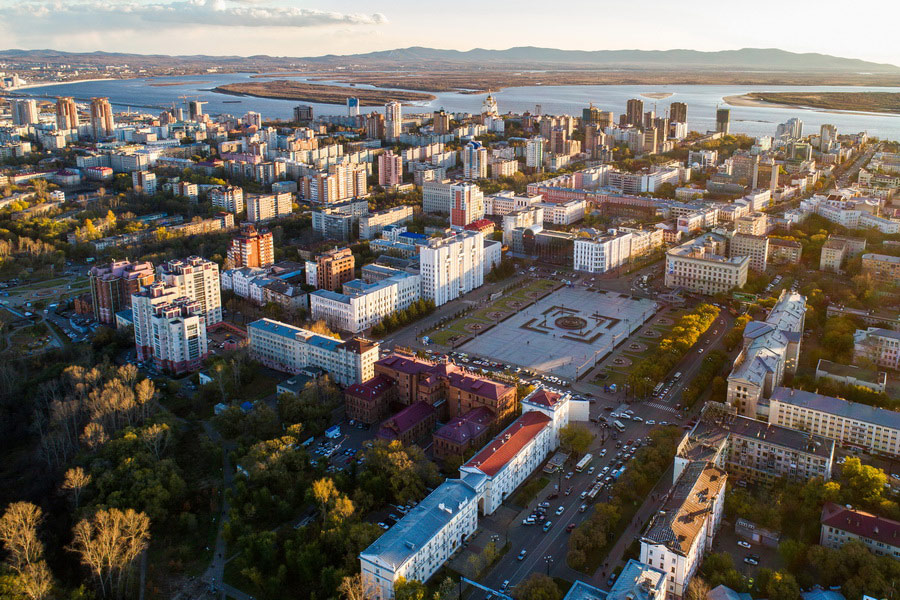
Tours, Attractions and Things To Do in Khabarovsk
Khabarovsk travel guide.
- 1. Architecture
- 2. Attractions
- 3. Cultural life
- 4. Souvenirs
Khabarovsk, Russia fascinates visitors with its unusual heritage and fabulous untouched nature. Tourists are drawn to the native culture, eclectic architecture and mesmerizing waters in this off-the-beaten-track destination, which promises a unique and memorable vacation.
As the center of Russia’s far eastern region of Khabarovsk Krai, the city offers celebrations throughout the year which are sure to give added flair to your trip, from traditional culture days to large-scale food fests. It is easy to keep a full itinerary during your stay thanks to its many theaters, museums, restaurants, workshops and quest rooms. Guests who want a more relaxed holiday can venture into the serenity of Khabarovsk nature, including the coast of the Sea of Japan or one of the region’s many picturesque lakes .
Khabarovsk Architecture
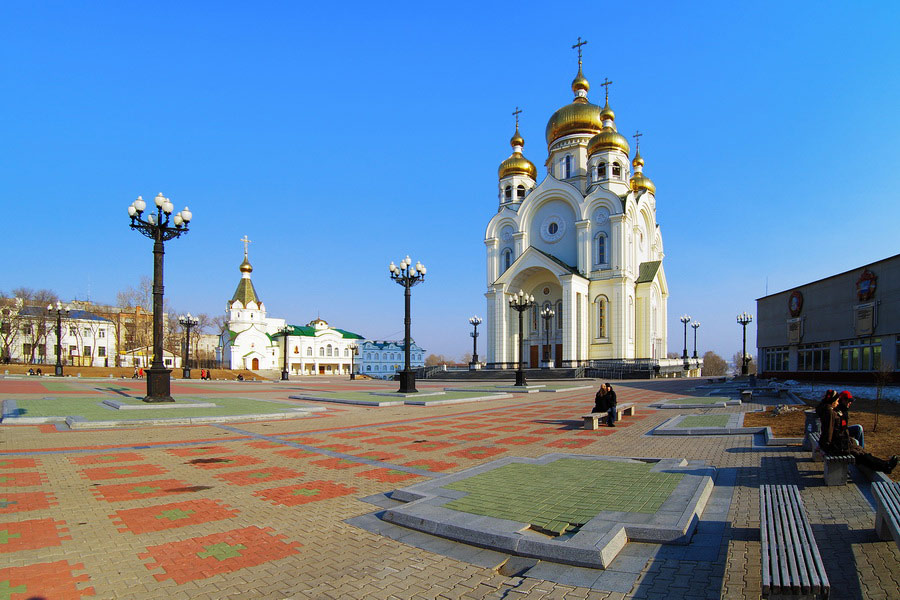
Khabarovsk architecture surprises with its harmonious blending of varying types and styles. This is due in large part to major changes which the city underwent in the mid-19th-early 20th centuries in conjunction with developments in the political, economic, scientific and technical spheres. The search for new trends in architecture came after the death of the classicism style, which had dominated the Russian Empire and the wider world for centuries. Beginning in the mid-19th century, the practice of mixing eclectic architectural styles began to emerge, leading to an era of amazing stylistic improvisations.
During the final decades of Romanov reign, many educational institutions for architects and engineers were opened. As a result, the face of numerous Russian cities began to change rapidly. Art Nouveau - a new, modern trend that absorbed several preceding styles – had come to dominate the architectural scene.
Many Art Nouveau buildings can still be seen in central Khabarovsk. These include:
- Takeuchi apartment building (5 Muravyov-Amursky Street)
- Esplanade Hotel (18 Muravyov-Amursky Street)
- Luhta apartment building (84 Komsomolskaya Street)
- Zandau apartment building (34 Muravyov-Amursky Street)
Khabarovsk also has many Gothic buildings, a style distinguished by its elegance and attention to detail. Every element of Gothic architecture emphasize a vertical orientation, as seen in the massive walls and columns, round arches and wide windows which contrast with narrow towers, pointed peaks and lancet windows.
Khabarovsk’s Gothic architecture is best represented by the artillery warehouse buildings located at 16 Komsomolskaya Street. Another notable example is the Red Guard Headquarters (105 Komsomolskaya Street), which has been preserved in its original form. The complex consists of two identical two-story brick buildings with unusual motifs containing pseudo-gothic elements.
Also of note is the early 20th-century Treasury Building, a luxurious red brick structure with openwork balconies that exudes an architectural grace.
Khabarovsk also has many Soviet-era buildings which were mostly designed in the constructivism style. Characterized by their enormous size and grotesque shapes, they often occupy most of the block and dominate the surrounding space.
During your Khabarovsk excursion, be sure to appreciate its unique architectural heritage by going for a walk downtown .
Khabarovsk Attractions
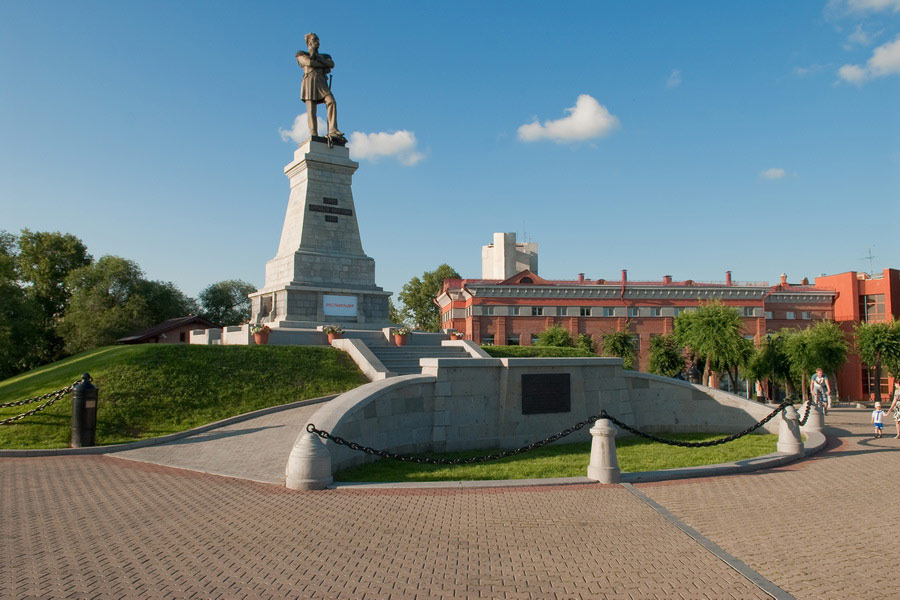
The layout of Khabarovsk is very simple: its 3 main streets of Lenin, Muravyov-Amursky and Seryshev pass through the downtown area, while Ussuriysky and Amur Boulevards run perpendicular to them. A distinctive feature of Khabarovsk are its many hills, so we recommend wearing comfortable shoes for your walk.
Begin your walking tour of Khabarovsk from the train station, where you can see the monument to Yerofey Khabarov, the famous explorer for whom the city is named. Nearby is a sculpture of a double-headed eagle, erected in memory of soldiers, officers and builders of the Far Eastern Railway. Moving from the station along Amur Boulevard you will reach the central market, just past which is Lenin Square. A spacious area with a granite fountain in the center, it is the main plaza of Khabarovsk and the site of the city’s Christmas and New Year celebrations. Next to the square is Dynamo Park, famous for its three ponds and Ferris wheel.
From Lenin Square, move along Muravyov-Amursky Street to reach Amur Embankment, passing most of Khabarovsk’s famous 19th-20th century buildings along the way. Descend to the embankment via two grand staircases or make a small detour onto Shevchenko Street, where you can follow the slope until you reach the embankment’s main stretch. Among other things, the area is home to the House of Officers and three museums.
As you move along the embankment through a park you will come across the city symbol of Khabarovsk, a building set on a steep cliff above the Amur River. It was at the foot of this cliff that the founders of a military post, the first semblance of civilization in the area, first landed.
After reaching the river and walking along Ussuriysky Boulevard to Turgenev Street, turn right to reach Glory Square. Here you will find another famous Khabarovsk landmark, Transfiguration Cathedral, along with a magnificent view of the Amur River and its dreamy islands. Glory Square concludes the main walking route of Khabarovsk, but from here you can reach any part of the city by public transport or taxi .
Khabarovsk Cultural Life
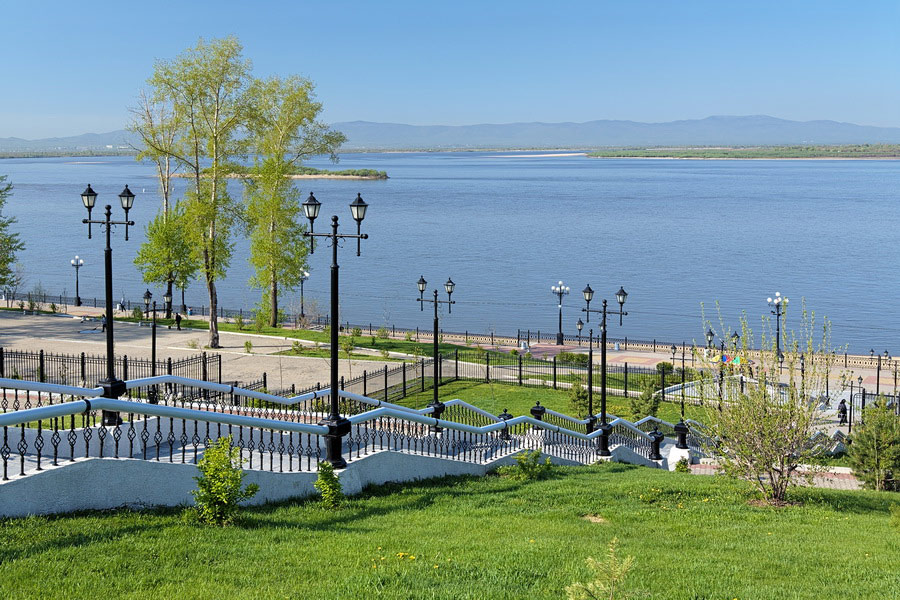
Khabarovsk entertainment centers around its many theaters and museums. Visit Khabarovsk Museum of Local Lore to get a better glimpse of city and regional life. Children and adults alike will want to visit Fishes of Amur River Museum, an aquarium which is home to some 90 species of the underwater world. To catch the vibe of local artists, head to the Far Eastern Art Museum.
There are several theaters in Khabarovsk, each of which is worth visiting:
- Khabarovsk Regional Puppet Theater;
- Triad Pantomime Theater;
- Khabarovsk Regional Philharmonic;
- White Theater, and others.
In addition, Khabarovsk offers several concert halls, culture houses, cinemas and art institutions .
Khabarovsk Souvenirs
While the city’s souvenir selection is not as diverse as in other Russian cities, guests can still find something suited to their tastes on their tour to Khabarovsk. Amur River and the Sea of Japan offer an abundance of seafood that can be tasted on the spot or brought home in dried or smoked form. Yet it is the rich culture of the local indigenous peoples which provides the largest selection of national souvenirs.
If you’re looking for an original gift, traditional Nanai slippers are comfortable and warm. Sewn from leather or fabric and decorated in a bright, colorful style before being trimmed with fur, they make the perfect house shoes in winter. Traditional decorations include amulets which are made from animal bones, fur or fabrics and decorated with ribbons and colored beads.
Standard souvenirs like plates, magnets, mugs and flasks stamped with images of Khabarovsk or its coat of arms can be purchased in souvenir shops, which are mostly located downtown and at the airport and railway station.

- Visit Our Blog about Russia to know more about Russian sights, history
- Check out our Russian cities and regions guides
- Follow us on Twitter and Facebook to better understand Russia
- Info about getting Russian visa , the main airports , how to rent an apartment
- Our Expert answers your questions about Russia, some tips about sending flowers

Russian regions
- Amur oblast
- Buryat republic
- Chukotka okrug
- Jewish autonomous oblast
- Kamchatka krai
- Khabarovsk krai
- Komsomolsk-on-Amur
- Magadan oblast
- Primorye krai
- Sakha republic
- Sakhalin oblast
- Zabaikalsky krai
- Map of Russia
- All cities and regions
- Blog about Russia
- News from Russia
- How to get a visa
- Flights to Russia
- Russian hotels
- Renting apartments
- Russian currency
- FIFA World Cup 2018
- Submit an article
- Flowers to Russia
- Ask our Expert
Khabarovsk city, Russia
The capital city of Khabarovsk krai .
Khabarovsk - Overview
Khabarovsk , the administrative center of Khabarovsk Krai, is one of the largest industrial, transport, cultural, educational, and scientific centers of the Far East of Russia. This city is located at the intersection of international railway and air transport routes on the right bank of the Amur River, near the border with China.
The population of Khabarovsk is about 613,500 (2022), the area - 383 sq. km.
The phone code - +7 4212, the postal codes - 680000-680150.
Khabarovsk city flag
Khabarovsk city coat of arms.
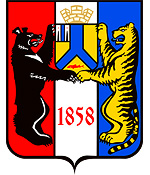
Khabarovsk city map, Russia
Khabarovsk city latest news and posts from our blog:.
25 August, 2017 / Russian banknotes and the sights depicted on them .
1 August, 2017 / Khabarovsk - the view from above .
21 December, 2016 / Flying over diverse Russia .
21 April, 2013 / Khabarovsk - the center of the Russian Far East .
16 January, 2011 / Siberian tiger walking the highway .
More posts..
History of Khabarovsk
Foundation of khabarovsk.
Until the mid-19th century, the territory of present-day Khabarovsk, in accordance with the Nerchinsk Treaty, was located on a neutral territory, not delimited between the Qing Empire (China) and the Russian Empire. In 1858, the Aigun Treaty was signed, according to which the entire left bank of the Amur River passed into the possession of the Russian Empire, the right bank of the Amur to the Ussuri River became part of China.
After signing the treaty, the 13th Siberian Line Battalion was sent to establish settlements along the Amur. One of the new settlements was named Khabarovka - in honor of Yerofey Khabarov, a 17th-century Russian explorer known for his attempts to colonize this region for Russia. In 1864, the first plan for the development of the future town was made. By 1865, there were 1,294 residents in Khabarovka - mostly soldiers and officers.
Initially, only military buildings were constructed in Khabarovka. Five years after the foundation, there were already 167 buildings in the settlement including the house of the commander, barracks, warehouses, residential buildings, and trading shops. Due to its very convenient location at the confluence of the Amur and Ussuri rivers, Khabarovka began to develop very quickly.
Following the military settlers, civilians began to arrive from all parts of the Russian Empire including Moscow and St. Petersburg. At that time, their main occupations were hunting, fur trade, and fishing. The settlers were provided with free fertile land, which also contributed to the influx of new residents to Khabarovka.
More historical facts…
Khabarovsk - a regional center of the Russian Far East
In 1873, the first elementary school was opened in Khabarovka. The Russo-Chinese treaty of 1881 allowed duty-free trade in the 50-kilometer land border zone and the goods of Chinese and English manufacturers could be bought half cheaper here.
By 1880, Khabarovka was already a rather large settlement of Primorsky Oblast with a population of 2,036 people (47.3% - military, 23% - bourgeois, 21.3% - foreigners (mainly Chinese workers), 1.4% - representatives of the indigenous population, and 7% - officers, clergy, merchants, industrialists).
At that time, the capital of Primorsky Oblast was Nikolayevsk (today’s Nikolayevsk-on-Amur), but Khabarovka had a more advantageous geographical position, as it was located at the crossroads of all communication lines from Vladivostok and the coast. In 1880, Khabarovka became the center of Primorsky Oblast and transformed into a town. In 1893, the town was renamed Khabarovsk.
In 1894, the Amur (Khabarovsk) department of the Russian Geographical Society was created with a museum (the Khabarovsk Regional Museum of Local Lore) and a library. In 1895, the first vocational technical school was opened - the railway school of the Ministry of Railways. During these years, a lot of stone houses were built in Khabarovsk. Most of them are preserved in the city to this day.
In 1897, the first train departed from the Khabarovsk railway station. The Ussuri Railway connected Khabarovsk with Vladivostok. The population of the town was about 14,900 people.
Khabarovsk in the 20th century and beyond
In 1916, the construction of a railway bridge over the Amur was completed and Khabarovsk was connected by the Amur Railway with Eastern Siberia.
November 14, 1922, after the liquidation of the Far Eastern Republic, Khabarovsk became part of the Russian Soviet Federative Socialist Republic. On December 6, 1923, the administrative center of the Russian Far East was transferred to Khabarovsk from Chita. In 1925, the railway bridge over the Amur was restored.
On January 4, 1926, Far Eastern Krai was formed with its center in Khabarovsk. The population of the city was about 52 thousand people. On October 23, 1934, the Far Eastern Agricultural Research Institute was established in Khabarovsk. In 1936, Khabarovsk was connected by rail with Komsomolsk-on-Amur.
By 1939, the population of Khabarovsk increased to 200 thousand people. From June 1940, the command of the Far Eastern Front was deployed in Khabarovsk. From August 1945, the headquarters of the High Command of Soviet Forces in the Far East and the command of the 1st Far Eastern Front were stationed in the city.
On March 16, 1946, the Khabarovsk Drama Theater was created. In 1949, a trial was held in Khabarovsk in the case of former members of the Japanese Kwantung Army. The most significant changes in the city occurred in the post-war decades.
In 1960, the Khabarovsk television studio began broadcasting. On October 24, 1964, the Khabarovsk Shipyard produced the first “Rocket”, a famous Soviet hydrofoil ship. On September 1, 1967, the Khabarovsk Institute of Physical Education (the Far Eastern State Academy of Physical Culture) was opened. On September 1, 1968, the Khabarovsk State Institute of Arts and Culture was opened.
In 1975, the population of Khabarovsk was about 502,000 people. By 1990, Khabarovsk was formed as a multifunctional economic center of national importance. The population reached its maximum of 616 thousand people.
In May 2000, federal districts were formed in the Russian Federation. Khabarovsk became the center of the Far Eastern Federal District. In 2008, the railway station was completely renovated. In 2009, the reconstruction of the bridge across the Amur was finished. In late summer - early fall of 2013, Khabarovsk was affected by flooding, which became the strongest over the entire observation period since 1897.
On December 13, 2018, the center of the Far Eastern Federal District was moved from Khabarovsk to Vladivostok.
Pictures of Khabarovsk
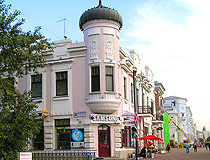
Pre-revolutionary architecture in Khabarovsk
Author: Tanya Yakushina
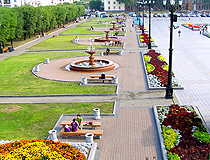
Lenin Square in Khabarovsk
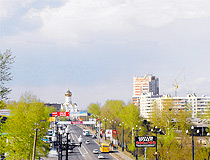
Khabarovsk cityscape
Author: Santiago Rios
Khabarovsk - Features
Khabarovsk is often considered the capital of the Russian Far East. The city is located in Asia, in the southern part of the Central Amur Lowland, near the confluence of the Amur and Ussuri rivers, about 17 km from the border with China. The city stands on the elevated right bank of the Amur River, the relief of which is diverse and complex.
The distance from Moscow to Khabarovsk by roads is about 8,250 km, to Vladivostok - 750 km. About half of the population of Khabarovsk Krai lives in this city. Khabarovsk is a bit similar to the large cities of the Volga region. Here you can see similar new buildings wedging chaotically into the cityscape and an abundance of pre-revolutionary architecture.
Although Khabarovsk can’t boast of Vladivostok’s seaside flavor or all-Russian sights, it’s still worth coming here, and to some extent this is inevitable: all routes of the Khabarovsk region converge here.
The climate in Khabarovsk is temperate monsoon, with snowy cold winters and hot humid summers. The average temperature in January is minus 20.5 degrees Celsius, in July - plus 21.8 degrees Celsius. The number of sunny days per year is significantly higher than in a number of large cities of Russia (up to 300 days a year; in Moscow and St. Petersburg - about 100).
From November to March, very dry and frosty continental air with clear and sunny weather is established over the city. The best time to visit Khabarovsk is June and September when the weather is not too hot.
Khabarovsk is a major hub at the junction of water, air, rail, and road communications from the north and west of the country, Primorye, Sakhalin, and the ports of Khabarovsk Krai. The Trans-Siberian Railway passes through the city, as well as the railway line to Komsomolsk-on-Amur. This city is the connecting point of the federal highways “Amur” (Chita - Khabarovsk), “Ussuri” (Khabarovsk - Vladivostok), and Khabarovsk - Komsomolsk-on-Amur. Urban transport includes trams, trolleybuses, buses, minibuses, and taxis.
The international airport “Novy” offers regular flights to Moscow, Yekaterinburg, Vladivostok, Yakutsk, Novosibirsk, Irkutsk, Magadan, Petropavlovsk-Kamchatsky, Yuzhno-Sakhalinsk, Seoul (South Korea), Tokyo (Japan).
The design of the Russian 5,000 rubles banknote features Khabarovsk. On its front side you can see the monument to Muravyov-Amursky (the founder of Khabarovsk and Vladivostok) on the background of the embankment of the Amur River. The Khabarovsk bridge over the Amur is depicted on the back of the banknote. At the time of construction, in 1916, it was one of the longest bridges in the world and was called “The Amur Miracle”.
The fork-shaped cross depicted on the coat of arms of Khabarovsk symbolizes the location of the city at the confluence of the Amur and Ussuri rivers. Fish reminds of the main occupation of the first residents - fishing. The white-breasted bear and the Amur tiger are endemic to the Amur land.
Main Attractions of Khabarovsk
Khabarovsk Regional Museum named after Nikolai Grodekov . The expositions of this museum feature exhibits on the paleontology and geology of the Amur Region, the flora and fauna of the Far East, the fish of the Amur basin, the culture of the indigenous peoples of the Amur region and Russian settlers, the history of the development of the Russian Far East, the events of the Civil War in the Far East (1917-1922). The museum building (1896) is a monument of architecture, culture, and history of federal significance. Shevchenko Street, 11.
Amur (Khabarovsk) Cliff - the most beautiful place in the city located in the center of Admiral Gennady Nevelsky Embankment running along the Amur River bank, near the Khabarovsk Regional Museum. In 1858, a military detachment led by commander Yakov Dyachenko landed here. He decided to set up his camp here, which later became a military settlement, and even later - the village of Khabarovka.
Here you can find a good observation deck with beautiful views of the Amur River and the city. Nearby, there is a park with the famous monument to the Governor-General of Eastern Siberia Muravyov-Amursky. This monument is depicted on the Russian banknote of 5,000 rubles. Shevchenko Street, 15.
The Far Eastern Art Museum - the largest museum of fine art in the Russian Far East. The collection of this museum has about 16 thousand works of art of the Old Russian, Russian pre-revolutionary, Soviet, and modern periods. Here you can also see the Far Eastern and Western European fine art, the art of the peoples of the Amur Region, works of Russian icon painting of the 15th-20th centuries. Shevchenko Street, 7.
Military History Museum of the Far Eastern Military District . The museum exhibits documents, photographs, banners of all periods of the history of the Far Eastern Military District, starting with the Russian Civil War in the Far East and to our time. In the courtyard, there is an exhibition of military equipment. Shevchenko Street, 20.
Khabarovsk Assumption Cathedral - the first stone building and one of the largest churches in Khabarovsk. The original building was demolished in 1930. In 2002, the cathedral was restored according to a new architectural project in the Russian style with some eclectic features. The new cathedral as a whole differs from the original building, but has some of its elements. In particular, the shapes of the arches and domes of the new cathedral were taken from the old version. Sobornaya (Komsomolskaya) Square.
Khabarovsk Bridge (“The Amur Miracle”) - one of the main symbols of Khabarovsk. The construction of this bridge completed the Trans-Siberian Railway in 1916. This bridge is depicted on the Russian 5,000 Rubles banknote. In the 1990s, the bridge was reconstructed, its old openwork spans were dismantled. Nearby, you can find the Museum of the History of the Amur Bridge with the last preserved span of the original design.
Lenin Square - the central and most picturesque square in Khabarovsk. In size, it is second only to Red Square in Moscow. It is framed by buildings of various styles of architecture, size, and number of storeys. There are beautiful fountains, well-groomed flower beds, and trimmed lawns here.
Severny Park - a cascade of three small but very picturesque ponds. In the middle of the green lawns and trees there are small arbors, as well as a snow-white wedding palace. Nearby, you can see the Church of Seraphim of Sarov. Kakhovskaya Street, 1.
Khabarovsk city of Russia photos
Churches of khabarovsk.
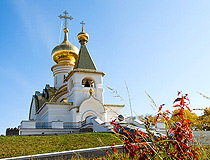
Church of St. Seraphim of Sarov in Khabarovsk
Author: Sergey V. Makogonov
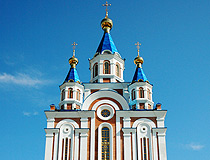
Assumption Cathedral in Khabarovsk
Author: Jason Rogers
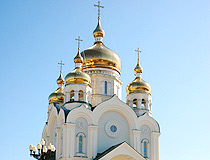
Transfiguration Cathedral in Khabarovsk
Lenin monument in Khabarovsk
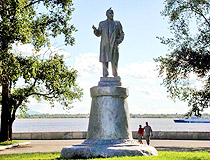
Lenin Monument in Khabarovsk
Author: Kudinov D.M.
The questions of our visitors
The comments of our visitors.
I lived in Khabarovsk for many years. I was an American working there. I spoke fluent Russian and pretty much blended right in. No one guessed I was a foreigner. I made lots of truly wonderful friends some of whom became like family.
I walked about any time I felt like it and never had any sort of problems. I lived in several other cities, including Moscow and St. Petersburg and Khabarovsk is my favorite. If I could figure out a way to live there permanently, I would with pleasure.
I had the pleasure of flying a number of flights to Khabarovsk in the early 1990's. I met some wonderful people, one very special person. While the city was in a semi state of disrepair, it still held the historic beauty of its earlier years.
It has been over 20 years since my visit and I would very much like to return. Perhaps not in this life time but the memories live on.
- Currently 2.86/5
Rating: 2.9 /5 (217 votes cast)
Sponsored Links:
Russia's Putin says he plans to visit China in May
- Medium Text
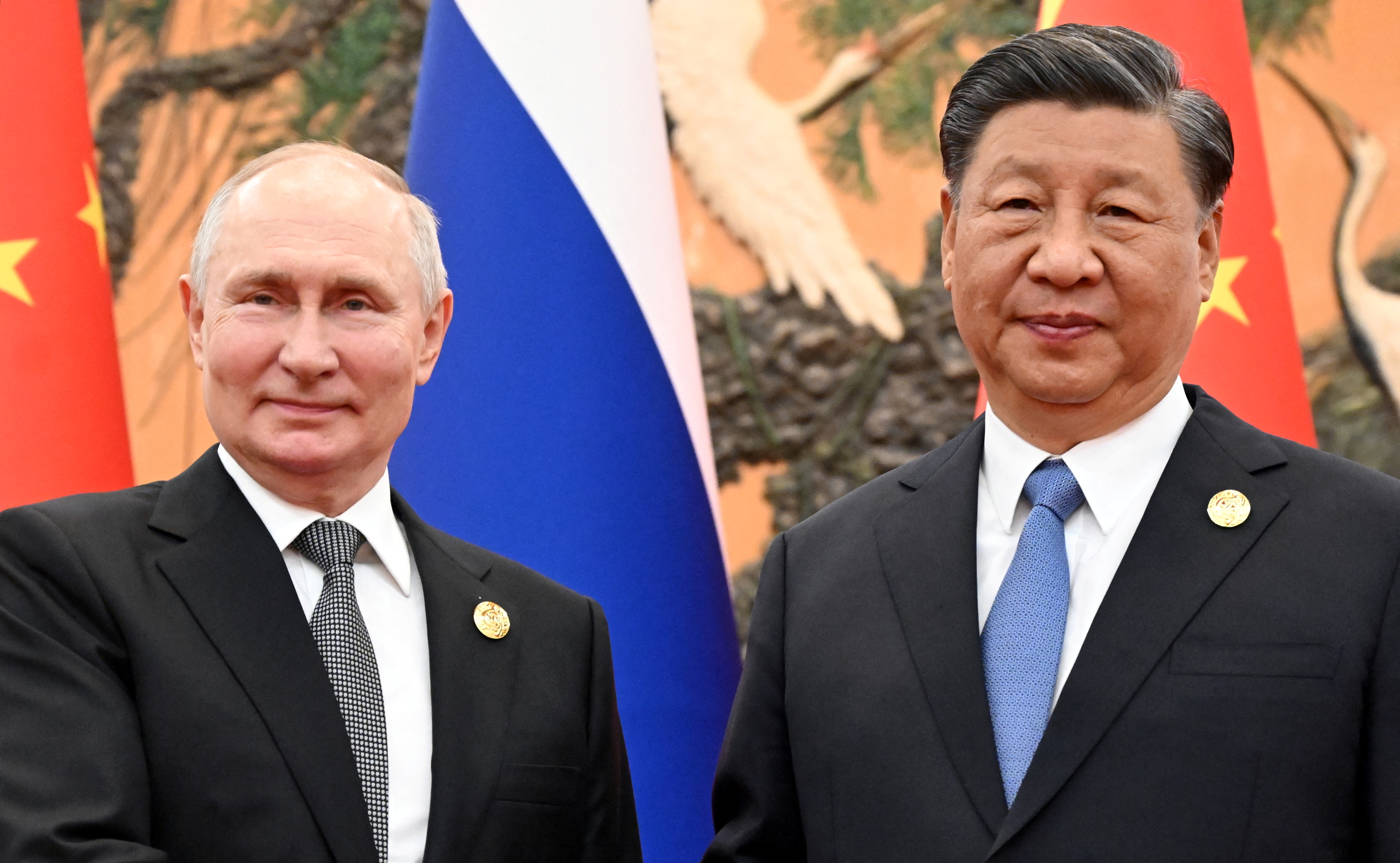
Sign up here.
Reporting by Reuters
Our Standards: The Thomson Reuters Trust Principles. New Tab , opens new tab
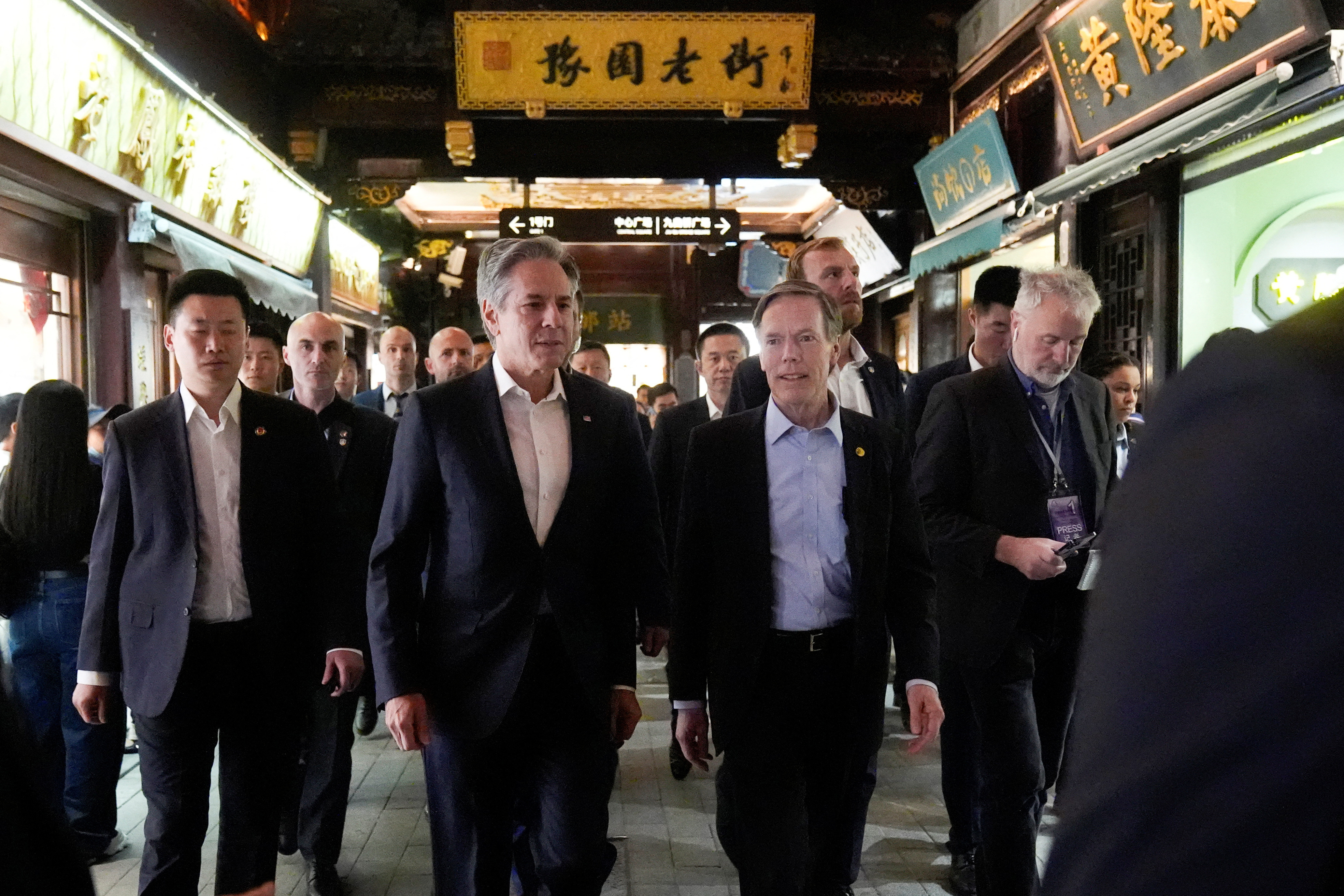
World Chevron
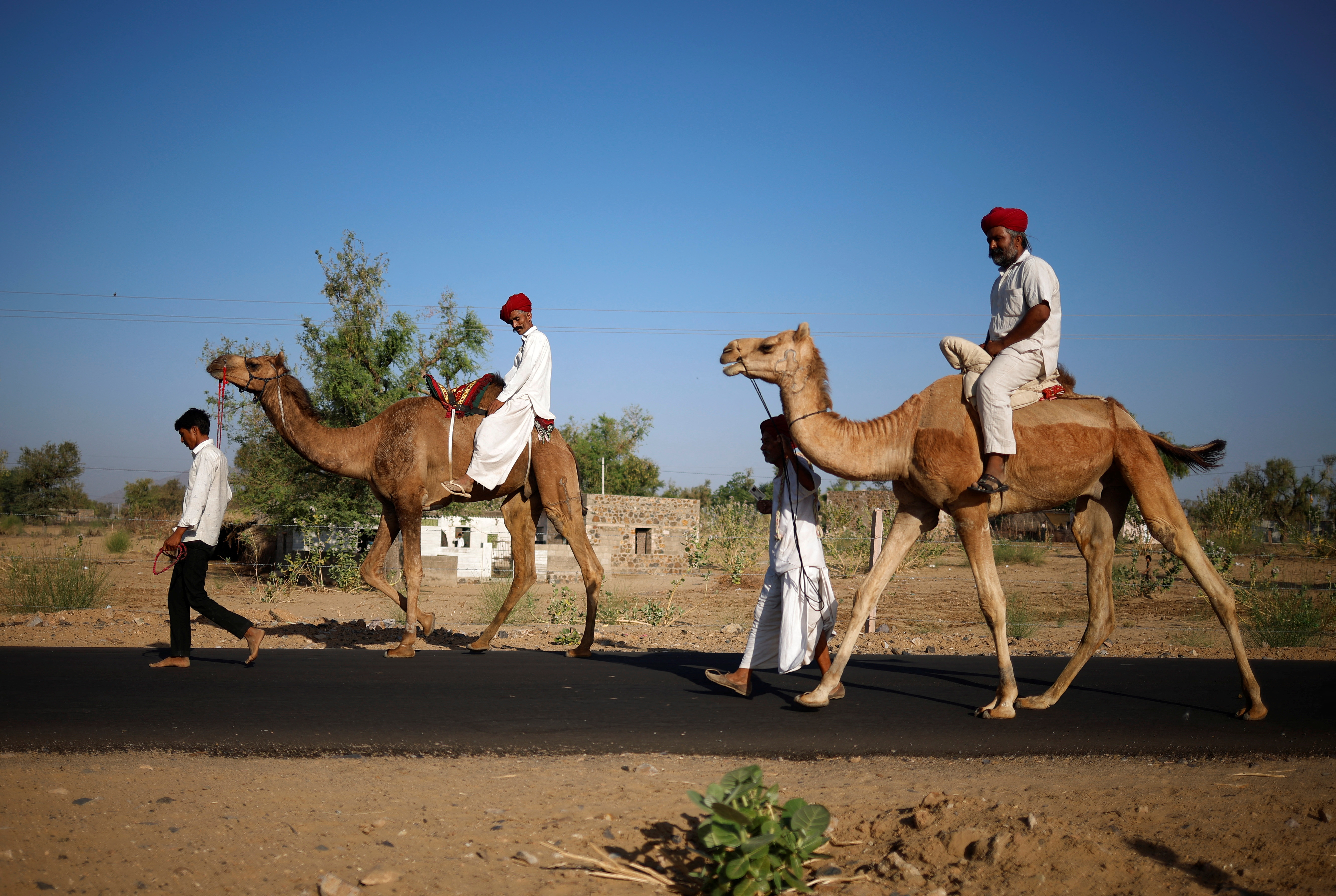
India Election: weeks of voting ahead as Modi eyes third term
The second round of voting in the world's biggest election started on Friday, with polling being held for 88 of 543 seats in India’s lower house of parliament.

Politics latest: Scotland's first minister Humza Yousaf says he will not resign as he faces prospect of no-confidence vote
Scotland's first minister is remaining defiant as he faces the prospect of a no-confidence vote. Listen to this week's episode of the Electoral Dysfunction podcast while you scroll through the latest updates.
Friday 26 April 2024 14:04, UK
Please use Chrome browser for a more accessible video player
- 'I intend absolutely to fight vote of no confidence,' Yousaf tells Sky News
- His political future in numbers - and how it may all come down to just one
- 'When they start caring about us, maybe we'll care back': Politics Hub special explores breakdown in trust between voters and politicians
- Serena Barker-Singh: Stark and bleak view from Target Towns voters
- Latest Electoral Dysfunction podcast explores what the local elections will bring
- Live reporting by Charlotte Chelsom-Pill
Scotland's first minister tells Sky News he has "every intention" of winning the vote of confidence against him.
Speaking live to Sky's Scotland correspondent Connor Gillies , Humza Yousaf accused the opposition parties of "playing games".
"I intend to fight that vote of no confidence. I've got every intention of winning that vote of no confidence," he said.
Mr Yousaf said he understand the "upset and anger" felt by the Scottish Greens after he scrapped their power-sharing agreement yesterday.
But he said the opposition must act in "good faith" in order to make a minority government work "in the interests of the people of Scotland".
He said he will be writing to all political party leaders and party groups represented in the Scottish parliament, including the leaders of the Greens, to ask them to meet with him.
Asked how he can be confident he will win the no-confidence vote, he says: "I believe in our ability to be able to work with, negotiate, compromise where necessary. We've shown that in the past."
"I'll be looking to do that over the next coming days with the opposition leaders.
"And with that, I'm quite confident, very confident, in fact, that we'll be able to win that vote of confidence."
Mr Yousaf confirms he has no intention of resigning.
Humza Yousaf's future as first minister is hanging in the balance ahead of a motion of no confidence next week.
Now, as leader of a minority government, his fate may be hanging on just one vote - that of a former SNP leadership rival.
We take a look at how:
The numbers
In the Scottish parliament, the SNP has 63 seats out of 129 , two short of an outright majority;
The Conservatives have 31;
Labour has 22;
The Greens have seven;
The Liberal Democrats have four;
The Alba Party has one ;
There is also one presiding officer Alison Johnstone, who is both an MSP and Scotland's equivalent of the Commons speaker.
How the numbers are expected to fall
The motion of no confidence was brought by the Scottish Conservatives.
The Greens, Labour and the Lib Dems have all said they are backing the motion.
That would translate into 64 votes against the first minister versus 63 SNP votes.
So the one Alba vote is expected to be key.
How it may all come down to one ... Ash Regan
Once an SNP leadership rival to Mr Yousaf, Ash Regan defected to Alex Salmond's Alba Party last October.
If she backs Mr Yousaf then that would mean both sides have 64 votes.
Ms Johnstone would then be expected to vote in favour of the status quo, so the first minister would survive.
But if Ms Regan votes against Mr Yousaf, then the opposition parties will have 65 votes against the SNP's 63, and the first minister would lose.
He wouldn't be compelled to resign in this situation, but he'd be under huge pressure to step aside.
More to come
And remember, Scottish Labour have lodged a separate motion of no confidence in the Scottish government.
Alba have said it won't back that motion.
Lib Dem leader Sir Ed Davey has backed Labour calls for an election in Scotland, describing the situation facing the SNP and first minister as a "total mess".
Scottish Labour have lodged a motion of no confidence in the government, saying "we need an election right now".
Humza Yousef is also facing a no-confidence vote on his leadership next week.
Put forward by the Conservatives, it has the backing of Labour, the Lib Dems and the Greens.
"It's a total mess with the SNP and Humza Yousaf," Sir Ed said during a visit to the River Goyt in Stockport.
"I personally think this SNP government has really failed Scotland."
He said the SNP has let Scotland down on key services such as health and education because the party has been "so focused on their ideological obsession of independence".
"On these basic things that matter to people, the SNP have been failing them and so Liberal Democrats have been saying in Scotland, look, we need to focus on the NHS, we need to focus on our schools, the cost of living, the environment."
"Because the SNP haven't done, I actually think it's time for a general election in Scotland."
Following the prime minister's trip to Europe this week, Beth Rigby , Jess Phillips and Ruth Davidson examine whether Rishi Sunak is convincing on the world stage and ask if his announcement on defence spending will help the Conservatives' chances in next week's local elections.
And after the Rwanda bill was passed this week - is this another win for the prime minister or a policy that he should have dumped months ago?
Plus, what's the future for Scottish First Minister Hamza Yusuf following the breakdown of the coalition between the SNP and the Greens. Ruth Davidson who was the leader of the Scottish Conservatives gives her verdict.
And how do MPs get deselected if they behave badly and can you become an MP if you have a past? The team answer more of your questions.
Listen here to the latest episode of Sky's Electoral Dysfunction podcast:
👉 Tap here to follow Electoral Dysfunction wherever you get your podcasts 👈
Email Beth, Jess, and Ruth at [email protected] , post on X to @BethRigby, or send a WhatsApp voice note on 07934 200 444.
With a general election looming, what counts as gains and losses for the main parties in next week's locals?
Sky's election analyst Michael Thrasher tells us what to look out for:
Lord David Cameron has said he is "deeply concerned" as a British man is charged with conducting hostile state activity to benefit Russia.
"While we must let the judicial process run its course, I am deeply concerned by allegations of British nationals carrying out criminal activity on UK soil to benefit the Russian state," the foreign secretary said.
"We will use the full weight of the criminal justice system to hold anyone found guilty of crimes linked to foreign interference to account."
Dylan Earl, 20, is alleged to have engaged in conduct targeting businesses which were linked to Ukraine in order to benefit the Russian state.
Nick Price, head of the Crown Prosecution Service's special crime and counter terrorism division, said: "Included in the alleged activity was involvement in the planning of an arson attack on a Ukrainian-linked commercial property in March 2024."
Four others have also been charged in connection with the investigation, the CPS said, after reporting restrictions were lifted on Friday.
Home Secretary James Cleverly said: "Hostile foreign acts will never be tolerated on UK soil.
"Our National Security Act has allowed charges to be brought against an individual alleged to be carrying out harmful activity for the benefit of the Russian state.
"If you threaten UK security, you will face justice."
Read more here:
By Daniel Dunford , senior data journalist
There might not be a general election just yet, but there are important votes that will define how the areas around us are run for the next four years.
See what's happening where you are here:
Labour's shadow chancellor says it is "time for a fresh start in Scotland", reiterating calls for a fresh election from Scottish Labour's Anas Sarwar.
Scottish Labour say they are putting forward a motion of no condolence in the government today.
They have also said they will back a motion of no confidence next week in First Minister Humza Yousaf.
"The chaos and division at the heart of the SNP is having a real impact on public services and the lives of communities across Scotland," Rachel Reeves says.
"And we now have two broken governments - the SNP in Scotland and the Conservatives in Westminster.
"It is time for fresh elections in Scotland and across the UK."
The shadow chancellor was speaking during a visit to Tees Valley today, where she and Labour leader Sir Keir Starmer are discussing the cost of living.
Earlier, the Scottish Labour leader said it is a matter of "when, not if" the first minister resigns ( see post at 11.56am ).
"But this isn't just about him [Humza Yousaf]," Mr Sarwar said.
"We have no confidence in this SNP government.
"That is why we need an election right now."
Scottish politics is in "utter chaos", a Greens source tells Sky News, as the first minister faces a no-confidence motion and Scottish Labour has said it will file a separate motion against the government.
The Greens, who were ousted from a power-sharing agreement with the SNP yesterday, have said they will back the motion of no confidence in Humza Yousaf.
However, the Greens source said the party is undecided on the motion of no confidence in the government.
The leader of Scottish Labour says it is a matter of "when, not if" the first minister resigns.
Humza Yousaf is facing a motion of no confidence, put forward by the Conservatives and backed by the Greens, Labour and Lib Dems, next week.
However, Labour has said it will also table a motion of no confidence in the SNP government.
In a video posted on X, Anas Sarwar said "this isn't just about him [Humza Yousaf]".
A short time ago, the Alba Party said it would not be backing Labour's motion (see previous post).
However Alba's one MSP, Ash Regan, may prove to have the deciding vote in the motion of no confidence in Mr Yousaf.
Be the first to get Breaking News
Install the Sky News app for free

- Skip to main content
- Keyboard shortcuts for audio player
U.S. raises alarms that China is helping Russia reconstitute its defense industry
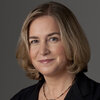
Michele Kelemen
China has told the world that that it is neutral in the Russia-Ukraine war, and that it is not providing weapons to Russia. Secretary of State Antony Blinken is expected visit to Beijing this month.
A MARTÍNEZ, HOST:
Secretary of State Antony Blinken heads to China this week, and while Blinken is in Beijing, there is bound to be talk of Congress' approval this weekend of $61 billion to Ukraine to fight Russia. Here's NPR's Michele Kelemen.
MICHELE KELEMEN, BYLINE: When she was still a top State Department official, the recently retired Victoria Nuland took part in several meetings with the Chinese about Ukraine.
VICTORIA NULAND: The Chinese have told the world that they are neutral in this conflict and that they are not providing weapons to Russia, but what they're doing instead is providing all of the inputs for weapons.
KELEMEN: Ninety percent of Russia's microelectronics are now coming from China, she says. And that's not all.
NULAND: Machine tools that go into ballistic missiles, rocket motors, something called nitrocellulose, which is basically the gunpowder that makes things go boom, is all coming from China.
KELEMEN: China calls this normal trade. Nuland says that in some of the conversation she had, the Chinese either deny supporting Russia's war effort in Ukraine or say they will look into it.
NULAND: For Russia, it's a great deal because they get all the smart stuff coming from China that they can no longer produce themselves, and then all they have to do is put the pieces together. And we know this because we find it on the battlefield, and we find it in our analysis of how Russia is able to make this surge in defense production.
KELEMEN: Experts say it will be hard, maybe impossible, to drive a wedge between Russia and China, which declared a no-limits partnership on the eve of Russia's full-scale invasion of Ukraine. Alexander Gabuev, who runs the Carnegie Russia Eurasia Center in Berlin, says the leaders of the two countries have similar outlooks.
ALEXANDER GABUEV: Vladimir Putin and Xi Jinping are like-minded leaders that want to make their countries great again, and they share this suspicion and animosity towards the U.S. leadership that they define as U.S. global hegemony that seeks to undercut the rise of Beijing and Moscow.
KELEMEN: At the start of the war, the U.S. laid out some clear red lines for China, urging Beijing not to supply Russia with weapons. But Gabuev says there's plenty below that threshold that China could and is doing. And that's just in part because of economic reasons.
GABUEV: And I think that strategically, China also is taking a relaxed approach because it's not interested in Russia losing the war. It definitely doesn't want to lose Vladimir Putin as a partner.
KELEMEN: As Russia makes advances in Ukraine and reconstituting its defense industry with China's help, Gabuev says the U.S. is now trying to draw a new red line for China. But he says that Washington will need to be more specific and will need help from Europe. Secretary of State Antony Blinken says he heard a lot of concerns from the Europeans at a Group of Seven meeting in Italy.
ANTONY BLINKEN: China can't have it both ways. It can't purport to want to have positive, friendly relations with countries in Europe and at the same time be fueling the biggest threat to European security since the end of the Cold War.
KELEMEN: Former diplomat Victoria Nuland says the U.S. and its partners need to be talking about this more publicly, as China continues to claim that it's a neutral player in Ukraine.
NULAND: It's also offered to play a role in the future in any ongoing talks. But if it is known to be the military industrial back office for Russia's war effort, that makes it harder for it to make that case.
KELEMEN: She says it's fair to say that Russia would not have been able to stage its current offensive in Ukraine without weapons from North Korea and Iran, and without, in her words, the massive infusion of parts and knowhow from China.
Michele Kelemen, NPR News, the State Department.
Copyright © 2024 NPR. All rights reserved. Visit our website terms of use and permissions pages at www.npr.org for further information.
NPR transcripts are created on a rush deadline by an NPR contractor. This text may not be in its final form and may be updated or revised in the future. Accuracy and availability may vary. The authoritative record of NPR’s programming is the audio record.
Blinken will urge China to stop sending military supplies to Russia
SHANGHAI — Amid growing U.S. worries that Russia’s war on Ukraine is being made possible by Chinese support for Moscow’s defense industry, Secretary of State Antony Blinken arrived in China on Wednesday on a three-day mission to push leaders to cut ties with the Kremlin.
The conversations in Shanghai and Beijing will be aimed at managing an increasingly thorny and contentious relationship, with ongoing disputes about China’s role in the war in Ukraine, Beijing’s broad claims over the South China Sea and U.S. efforts to reduce dependence on China’s technology manufacturing sector.
The Senate’s passage on Tuesday of a bill requiring the Chinese owners of TikTok to divest from their company was sure to add additional contention on the Chinese side.
This will be the top American diplomat’s second visit to China since relations hit bottom early last year when a Chinese spy balloon floated across the continental United States.
American officials played down expectations for breakthroughs but said it was important to keep talking. More than two years into wide-ranging Western sanctions against Russia, the Biden administration blames China for what it says is a systematic effort to keep Moscow’s defense sector afloat, enabling further civilian deaths in Ukraine. Officials hope to deliver a message coordinated with Europe, which they believe will be more effective than the United States making a solo push.
“When it comes to Russia’s defense industrial base, the primary contributor in this moment to that is China,” Blinken told reporters last week after a meeting of leading world economies in Italy, saying that China has been sharing machine tools, semiconductors and other items that have helped Russia rebuild its defense industry two years into its full-scale war in Ukraine.
“If China purports on the one hand to want good relations with Europe and other countries, it can’t on the other hand be fueling what is the biggest threat to European security since the end of the Cold War,” Blinken said.
Beijing has bristled at Washington placing Ukraine front and center of attempts to thaw relations. Ukraine is “not an issue between China and the United States. The U.S. side should not turn it into one,” a senior Foreign Ministry official said in an unusually long and detailed rundown of Beijing’s demands for talks in a statement released on Tuesday.
Blinken’s last trip to China , in June, marked the resumption of communications after a period of near-silence between high-level leaders in both countries following a trip by former House speaker Nancy Pelosi to Taiwan in August 2022. Blinken was poised to make a trip that was canceled when the spy balloon floated across America just days before his scheduled departure.
But in recent months a steady stream of Cabinet secretaries has visited Beijing, while Chinese officials have made the return trip to the United States. Blinken isn’t even the first member of President Biden’s Cabinet to visit China this month, after Treasury Secretary Janet L. Yellen led an economic delegation and charmed her hosts by drinking beers in Beijing — even as she threatened sharper tariffs on steel and aluminum.
Still, with Chinese leader Xi Jinping showing little inclination to dial back his increasingly aggressive approach to projecting his nation’s power in the world, the United States is devoting significant diplomatic bandwidth to ringfencing China.
Biden and Blinken are building ties to China’s neighbors to try to discourage it from making moves against Taiwan, which Beijing claims as its own, and to warn it off its confrontational stance toward the sea fleets of other nations in the South China Sea. Earlier this month, Biden met the leaders of Japan and the Philippines together in the White House, part of a broader U.S. push to build small groupings of countries to work together to respond to Chinese activity.
Beijing has been especially unsettled by that U.S. strategy, arguing that the Biden administration is rerunning the Cold War playbook of containment that it once deployed against the Soviet Union. U.S. officials fire back that if China’s neighbors feel threatened and want to work with each other to bolster their security, then Beijing should reexamine the way it is projecting its power.
Still, the relationship is far more stable than it was a year ago, and China appears to be signaling that it does not want to risk crossing the reddest of U.S. red lines. It has dialed back its rhetoric and military activity around Taiwan in recent months. And — after the Biden administration delivered a stark warning — it still has not sent weaponry to Russia, Blinken said last week.
But U.S. officials say that even the current levels of Chinese support for the Kremlin are far too much. They have warned counterparts that if Chinese companies keep supplying embargoed dual-use components to Russia, they could face crippling sanctions of their own.
“We’re prepared to take steps when we believe necessary against firms that are taking steps in contravention to our interests,” a senior State Department official said ahead of the trip, speaking to reporters under ground rules of anonymity to discuss sensitive planning considerations. “Our objective will be to clearly make the case what the implications are of this support and why that may in fact not be in China’s interest going forward.”
The United States won’t be able to “drive a wedge” between China and Russia, so Blinken’s goal is to convince Xi that Beijing will bear “unacceptable consequences” if it doesn’t stop enabling Putin’s war effort, said Bonnie Glaser, managing director of the Indo-Pacific program at the German Marshall Fund, a think tank.
To appeal to the Chinese leader’s interests, the United States needs to show him that curbing support of Russia can help stabilize relations with Washington, Glaser said. “China really does not want to be front and center in our election campaign,” she added.
A key goal for China is to ease American export controls on advanced technologies, after Xi warned Biden in San Francisco that more restrictions could “deprive the Chinese people of their right to development.”
Still, some officials said they did not expect an immediate shift in Chinese behavior. With Biden already working to isolate Chinese industry and detach trade ties to Beijing, he has less leverage over China’s economy than in the past. Nor is China in the mood to split from the Kremlin, viewing Russia as a key partner in a world it sees as largely under by U.S. hegemony.
According to Shi Yinhong, a scholar at Renmin University in Beijing, there remain 16 sources of serious tension in the relationship, “none of which have seen lasting mitigation even with more dialogue since [former president Donald] Trump left office.”
On his list are military activity around Taiwan and in the South China Sea; human rights in Hong Kong and Xinjiang; decoupling in technology industries and efforts to safeguard supply chains; and growing ideological competition as part of a new Cold War. “On every major issue there is an established pattern,” Shi said. “It’s very difficult to make positive change.”
Shepherd reported from Shanghai.
This article originally paraphrased Glaser as saying that Blinken needed to convince Xi the United States was not trying to drive a wedge between China and Russia. She merely said that was not achievable for Blinken to do this. This article has been updated.

- Bahasa Indonesia
- Slovenščina
- Science & Tech
- Russian Kitchen
Khabarovsk: Keystone of the Russian Far East
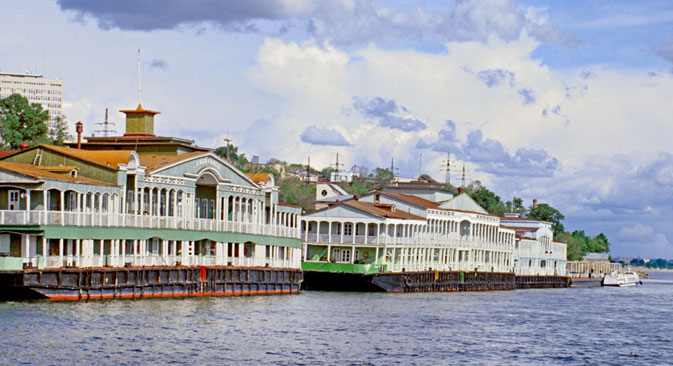
Photographs by William Brumfield
By rail, the city of Khabarovsk in the Russian Far East is a six-day, 5,300 mile journey from Moscow. Given the distance, it’s unsurprising that most visitors prefer to make the trip by air. The nine-hour flight has the added advantage of giving travelers a dramatic overview of the Amur River on the approach.
Indeed, Khabarovsk is a city of two great strategic rivers: the Amur, which flows eastward along the border with China; and the Ussuri, which flows northward some 560 miles from its origins in the southern Sikhote-Alin Mountains, not far from the Sea of Japan. The confluence of these two rivers near Khabarovsk, and the state boundaries they define have created one of the most important geopolitical zones in northern Asia.
Russian explorers attempted to gain control of the north bank of the Amur as early as the 1640s, but Russia was compelled to abandon the area by the Treaty of Nerchinsk, signed in 1689. Russian troops did not return to the region in substantial numbers until the mid-19 th century, under the leadership of Governor-General Nikolai Muravyov.
He was later given the title “Amursky” for his role in acquiring the territory for the Russian empire. In the Treaty of Aigun (1858), negotiated with the Qing Dynasty, China ceded to Russia territory north of the Amur and east of the Ussuri.
Khabarovsk arose as a consequence of the Treaty of Aigun. The first Russian settlement was established in May 1858 by a detachment of Siberian troops under the command of Captain Yakov Dyachenko. The post was initially named Khabarovka in homage to the renowned 17th-century Cossack leader Yerofei Khabarov, who explored the area.
The settlement rapidly expanded, and by 1864 it already had a formal plan for development on hilly terrain along the left bank of the Amur. A telegraph line to Vladivostok began operating in 1868, and a proper river port was completed in 1874. By the end of 1880, Khabarovsk had gained over 4,000 inhabitants and an official status as a town.
How to get there
To get to Khabarovsk from Moscow of St. Petersburg take a regular flight. The trip takes approximately 7,5 hours.
Entrepreneurs looking to capitalize on the development of river trading routes were quick to settle in the young town, which offered considerable potential for commerce with China. Progress in transportation also led to increased government authority. In 1884, Khabarovsk became the administrative center of a vast area stretching from the Amur River to the Pacific.
The town’s status was further enhanced in late May 1891 when the heir to the throne, Tsarevich Nicholas Alexandrovich (subsequently Nicholas II) included Khabarovka on the itinerary of his nine-month-long world tour.
At the time of his visit, the town unveiled a heroic monument to Muravyov-Amursky by the noted sculptor Alexander Opekushin. Dismantled during the Soviet period, the monument has since been restored to a prominent position overlooking the river. In 1893, the town’s name was changed from Khabarovka to the more formal Khabarovsk.
Perhaps the greatest catalyst for the town’s early growth was the completion of a rail line from Vladivostok in 1897. Khabarovsk now had a direct link to a growing international port, even as it controlled interior river traffic over the extensive territory of the Amur River basin.
The town’s strategic location was not lost on military planners, who developed local machine factories to equip the armed forces of the Far East. At the same time, Khabarovsk, like the rest of Russia, experienced severe labor and military unrest in 1905-06 following the country’s defeat in the Russo-Japanese War.
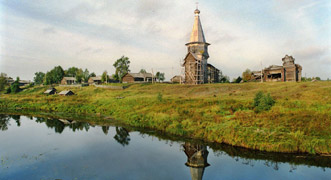
With the return to stability under Prime Minister Pyotr Stolypin (1862-1911), Khabarovsk continued its rapid growth. During the three decades from 1884 to the beginning of World War I, the population increased more than 10-fold. And in 1908, Khabarovsk became the headquarters of the Amur River Flotilla, with responsibility for patrolling the long frontier with Manchuria.
In 1914, connections were improved with the Trans-Siberian Railway, which gave Khabarovsk access to distant Moscow and St. Petersburg. At that time, however, the rail route to the Russian Far East still went through Manchuria along the Chinese Eastern Railway.
The town was linked directly to eastern Siberia only in 1916, with the completion of a bridge across the Amur just to the northwest of Khabarovsk. Built in difficult conditions within three years, the bridge was one of the major achievements of Russian engineering.
To this day the attractive, often imposing architecture of central Khabarovsk reflects the prosperity of the town at the turn of the 20 th century. Using an eclectic mixture of neoclassicism and medieval Russian elements, architects designed enduring, well-built structures for housing, commerce and administration. A peculiar local feature was the use of high quality, unstuccoed red brick for the structure, with gray brick for decorative trim.
The most visible indicator of prosperity and rising consumer demand was the large department store. Firms such as Kunst and Albers, which had stores in several towns, and the Pyankov Brothers used architecture to create an impressive display for retail trade. The large Plyusnin building, subsequently converted to the Regional Library, contained one of the town’s many banks. The best of these buildings are on the main street, which is named after Muravyov-Amursky.
Other historic buildings display the style moderne that was fashionable at the beginning of the 20 th century, with traces of traditional Russian decoration. The best example is the former building of the city council, now carefully restored.
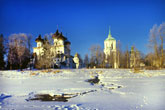
The Shrines of Kargopol: Preserving the art of the Russian North
The devastation of World War I occurred far from Khabarovsk, and the city actually grew with expanding military production. But the civil war following the Bolshevik Revolution caused major damage and disruption.
The last major battles of the Civil War occurred near Khabarovsk. Red partisan forces recaptured the town in early 1920, but they were suddenly attacked by the Japanese in April. Fierce fighting led to significant destruction in the central district. Instability continued until December 1921, when the city was retaken by a White army led by Viktorin Molchanov.
At the battle of Volochaevka in February 1922, Molchanov’s defenses were breached and Khabarovsk was retaken by Red forces, but not without further damage to the area, including partial demolition of the magnificent Amur River Bridge. Authority was vested in the Far Eastern Republic, a Communist ally that formally merged with the new Soviet state in November 1922.
During the Soviet period, the expansion of Khabarovsk accelerated thanks to its strategic military, industrial and administrative position. The pace of growth is reflected in modernist buildings designed by prominent Constructivist architects such as Ilya Golosov, who built the large complex for the House of Soviets in 1929-30.
In the 1930s the Gulag concentration camp empire expanded and prison labor was used in construction. A number of building projects in Khabarovsk were undertaken by the NKVD, which preferred a pompous neoclassical style. Relics of that time include the GlavDalStroi Building and the Commune House, all on Muravyov-Amursky Street.
World War II, like the first, occurred far from Khabarovsk, but the city played a major role in defending the Far East from a Japanese attack. And it served as headquarters during the brief Soviet-Japanese War in August 1945

Liavlia and Zaostrovye: Enduring traditions in the Arkhangelsk Region
Greatly expanded after the war, Khabarovsk maintained its momentum into the post-Soviet period. The city’s vitality is reflected in the improved appearance of Muravyov-Amursky Street, from a renovated Lenin Square to Cathedral Square, with its new Dormition Cathedral visible from the Amur. In 2004 the Transfiguration Cathedral was consecrated on Glory Square near the river.
With a population of just over 600,000, Khabarovsk has witnessed a building spree of contemporary apartment houses in colorful post-modernist forms. And the city’s good management was acknowledged in 2000 when it was chosen as the headquarters of the Far Eastern Federal District.
In the late summer of 2013 the Khabarovsk area experienced a record-setting flood of the Amur, but the main part of the city — on high ground — avoided the worst of the destruction. Among the city's promising economic developments is its pivotal role in the massive "Strength of Siberia" gas pipeline project, which will link the gas fields of Yakutia to the rapidly expanding Chinese market. With its well-maintained central district, Khabarovsk preserves its heritage as it looks to the future.
All rights reserved by Rossiyskaya Gazeta.
to our newsletter!
Get the week's best stories straight to your inbox
This website uses cookies. Click here to find out more.
- Share full article
Advertisement
Supported by
Xi and Blinken Trade Small Nods Over a Large Gap
The U.S. secretary of state and the Chinese leader struck conciliatory notes in Beijing. But there was no budging on, or hiding, their governments’ core differences.

By Ana Swanson and Vivian Wang
The areas where the United States and China can work together seem to be shrinking fast, and the risks of confrontation are growing. But it was clear on Friday that both countries are trying to salvage what they can.
Preserving some semblance of cooperation — and the difficulty of doing so — was at the heart of a meeting between Secretary of State Antony J. Blinken and China’s leader, Xi Jinping, in Beijing on Friday. It was the latest effort by the rivals to keep communications open even as disputes escalate over trade, national security and geopolitical frictions.
Officials in both countries said they had made progress on a few smaller, pragmatic fronts, including setting up the first U.S.-China talks on artificial intelligence in the coming weeks. They also said they would continue improving communications between their militaries and increase cultural exchanges.
But on fundamental strategic issues, each side held little hope of moving the other, and they appeared wary of the possibility of sliding into further conflict.
China has accused the United States of working to stifle its technological progress and encircle Chinese interests in the Pacific.
The Biden administration is deeply concerned that cheap Chinese exports are endangering U.S. jobs, and is threatening more sanctions on China if Beijing does not roll back its support of Russia in its war in Ukraine.
“Russia would struggle to sustain its assault on Ukraine without China’s support,” Mr. Blinken said at a pre-departure news conference on Friday. “I made clear that if China does not address this problem, we will.”
Mr. Blinken said he had pressed China to take further actions to stem the flow of materials used to make fentanyl, including prosecuting those who were selling chemicals and equipment.
He said the issue of TikTok, the Chinese-owned social media platform that faces a potential U.S. ban in nine to 12 months under a law passed this week, did not come up.
In a sign of how the countries’ relations — which hit perhaps their lowest point in decades last year — had stabilized in recent months, Chinese officials struck a more conciliatory tone on Friday than they had during Mr. Blinken’s last visit, in June .
“China is happy to see a confident, open, prosperous and thriving United States” Mr. Xi told Mr. Blinken, according to a Chinese foreign ministry readout. “We hope the U.S. can also look at China’s development in a positive light.”
Mr. Blinken told Mr. Xi that he hoped to move forward on agreements on topics where Mr. Xi and President Biden had agreed to cooperate after they met near San Francisco in November.
“We are committed to maintaining and strengthening lines of communication to advance that agenda and again deal responsibly with our differences so we avoid any miscommunications, any misperceptions, any miscalculations,” Mr. Blinken said.
Still, more factors appear to be driving the two countries apart than keeping them together. Geopolitical disputes in Ukraine and the Middle East have presented new challenges. With an election approaching in the United States, the Biden administration is under pressure to offer more protections for American factories against Chinese imports.
Mr. Xi told Mr. Blinken that “the international situation is fluid and turbulent,” and that the United States and China should “honor words with actions, rather than say one thing but do the opposite,” according to the Chinese readout.
China’s foreign minister, Wang Yi, who spent over five hours with Mr. Blinken on Friday, was more blunt, warning that negative factors in the relationship were “increasing and building.”
In recent weeks, U.S. officials have begun more urgently raising concerns about China’s economic assistance to Russia and have held out the possibility of further sanctions, including on the Chinese banks that have financed the trade.
Mr. Blinken said on Friday that the Chinese support for Russia was creating a threat not just to Ukraine, but to Europe more broadly, and that European leaders shared those concerns.
“All I can tell you is I was extremely clear about our concerns in some detail,” he said. “But we’ll have to see what actions follow from that.”
In a briefing with reporters in mid-April, a senior Biden administration official said that China had provided Russia with significant quantities of semiconductors, drones and industrial materials. That was helping to fill critical gaps in Russian supply chains that might otherwise cripple Russia’s war effort, causing the Russian military sector to expand more quickly than American officials had believed possible.
China has denied providing weapons to Russia, which Washington has said would be a red line. Otherwise, though, Chinese officials have shown little inclination to scale back their ties with Russia. On Thursday, soon after Mr. Blinken arrived in Beijing from Shanghai, President Vladimir V. Putin of Russia announced that he would visit China in May, in probably his first overseas trip since securing re-election last month.
Asked about Mr. Putin’s announcement at a routine news briefing on Friday, a spokesman for the Chinese foreign ministry said he had no information to provide.
Trade frictions between the countries also continue to simmer, as American officials consider adding new tariffs on Chinese imports and restricting more exports of technology to China because of national security concerns.
Economic ties between the countries have long provided a source of strength for the relationship, a point Mr. Blinken reiterated while meeting with business executives in Shanghai on Thursday.
But with American businesses calling for more protections against China, and the prospect of a return of Donald J. Trump to the presidency, economic issues could turn more explosive.
To jump-start the economy, Mr. Xi and other Chinese leaders are stoking factory production and exports. But American leaders believe they must protect U.S. manufacturing, particularly the new factories making semiconductors, solar panels and car batteries in which the Biden administration is investing tens of billions of dollars this year.
At his news conference, Mr. Blinken said that China alone was producing more than 100 percent of global demand for products like solar panels and electric vehicles, and was responsible for one-third of global production but only one-tenth of global demand.
“This is a movie that we’ve seen before, and we know how it ends,” he said. “With American businesses shuttered and American jobs lost.”
Mr. Wang, the foreign minister, also saved some of his sharpest words for American trade policy. “The United States has adopted an endless stream of measures to suppress China’s economy, trade, science and technology,” he told Mr. Blinken during their meeting, according to the Chinese foreign ministry. “This is not fair competition but containment, and is not removing risks but creating risks.”
China knows that it likely has little room to sway the United States on trade, said Xie Tao, the dean of the School of International Relations and Diplomacy at Beijing Foreign Studies University. Instead, the Chinese government seems to be putting its focus on people-to-people exchanges, Professor Xie said.
Chinese media outlets have frequently raised Mr. Xi’s goal, announced after the summit near San Francisco last year, of inviting 50,000 young Americans to visit China. (Mr. Blinken said on Friday that he supported more Americans studying in China.)
“The Chinese government is really investing a lot of energy in shaping the future generation of Americans’ view of China,” Professor Xie said.
Li You contributed research
Ana Swanson covers trade and international economics for The Times and is based in Washington. She has been a journalist for more than a decade. More about Ana Swanson
Vivian Wang is a China correspondent based in Beijing, where she writes about how the country’s global rise and ambitions are shaping the daily lives of its people. More about Vivian Wang
China warns U.S. of 'downward spiral' as Antony Blinken meets with Xi Jinping
HONG KONG — Secretary of State Antony Blinken met with Chinese President Xi Jinping in Beijing on Friday as he wrapped up a three-day visit to China dominated by contentious issues and warnings from his hosts of another “downward spiral” in relations.
The two men met Friday afternoon local time at the Great Hall of the People, an ornate and cavernous building next to Tiananmen Square.
Xi noted that this year is the 45th anniversary of the establishment of diplomatic relations between the United States and China, and said the two countries “should be partners rather than adversaries.”
“The world is big enough to accommodate the simultaneous development and prosperity of both China and the United States,” he said, according to a Chinese Foreign Ministry readout, adding that U.S.-China relations will stabilize once the U.S. takes “a positive and constructive view of China’s development.”
Speaking to reporters after the meeting, Blinken said the U.S. did not aim to hold back China’s development or decouple the world’s two largest economies.
“We want China’s economy to grow,” he said, but “the way China grows matters.”
“That means fostering a healthy economic relationship where American workers and firms are treated equally and fairly,” said Blinken, who cited what he called China’s unfair trade practices and the risk that Chinese industrial overcapacity in key industries such as solar panels and electric vehicles could result in U.S. and other markets being flooded with Chinese products.
The visit is Blinken’s second in less than a year as the two superpowers work to stabilize ties with renewed talks despite a growing list of geopolitical differences.
A primary goal of Blinken’s visit to China was to warn about its support for Russia’s war against Ukraine, which began weeks after Moscow and Beijing declared a “no limits” partnership in 2022. Though China does not appear to be supplying Russia with lethal assistance, Blinken said Friday that it was providing machine tools, microelectronics and other dual-use items that make it the “top supplier” of Russia’s defense industrial base.
“Russia would struggle to sustain its assault on Ukraine without China’s support,” he said.
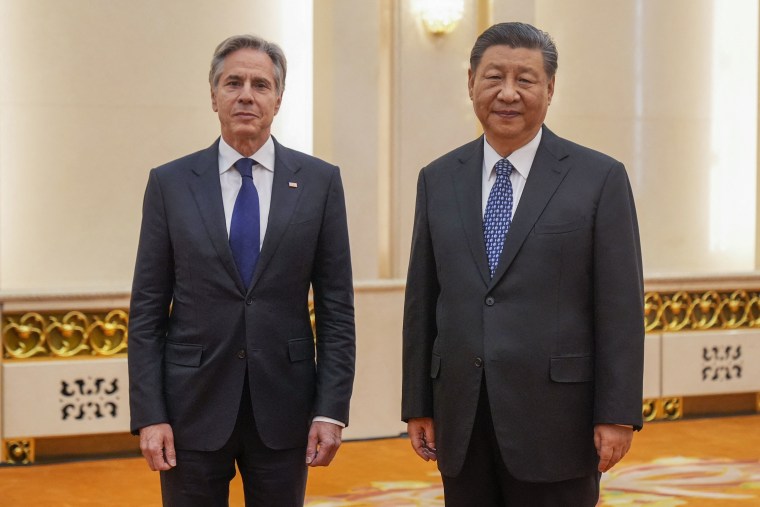
Other issues on the agenda included Chinese economic and trade practices the U.S. views as unfair, Chinese aggression in the South China Sea , stability in the Taiwan Strait, North Korea’s nuclear and missile programs and the Israel-Hamas war.
Earlier Friday, Blinken met with Chinese Foreign Minister Wang Yi at the Diaoyutai State Guesthouse, where foreign dignitaries are often received.
“There’s no substitute, in our judgment, for face-to-face diplomacy in order to try and move forward, but also to make sure that we’re as clear as possible about the areas where we have differences, at the very least, to avoid misunderstandings, to avoid miscalculations,” Blinken told Wang before the meeting.
Speaking through an interpreter before the meeting, Wang said the U.S.-China relationship “has gone through ups and downs and twists and turns.”
He said the relationship was beginning to stabilize but that “negative factors” were increasing.
“China’s legitimate development rights have been unreasonably suppressed and our core interests are facing challenges,” Wang said, in an apparent reference to U.S. export controls and other measures that Beijing says are intended to limit its economic growth.
“Should China and the United States keep to the right direction of moving forward with stability or return to a downward spiral?” he said. “This is a major question before our two countries.”
Blinken later described his meeting with Wang, which lasted more than three hours, as “extensive and constructive.”
According to a State Department readout, the two men discussed next steps on a range of commitments that Xi and President Joe Biden made at their summit in California in November, including advancing cooperation on counternarcotics, military-to-military communication, talks on artificial intelligence risks and safety, and facilitating people-to-people exchanges.
Blinken announced Friday that the U.S. and China would hold their first talks on artificial intelligence in the coming weeks.
The Biden-Xi summit, the first encounter between the two leaders in a year, was intended to stabilize U.S.-China relations that had reached their lowest point in decades amid disputes over trade, technology, the status of Taiwan and the downing of a suspected Chinese spy balloon over U.S. territory.
Though ties have improved since then, they are being tested by the strengthening of U.S. security alliances in the Asia-Pacific, U.S. concerns about Chinese goods flooding global markets, U.S. inquiries into China’s electric vehicle , shipbuilding and other industries, the possibility of increased U.S. tariffs on Chinese goods , and the passage this week of legislation that could result in a U.S. ban on the Chinese app TikTok .
The legislation, which Biden signed into law on Wednesday as Blinken was arriving in China, also includes $8 billion for security in Taiwan, a self-ruling island democracy that Beijing claims as its territory, and the broader Indo-Pacific, where the U.S. and China are competing for influence.
Blinken last visited China in June, when he also met with Xi. This trip also included a stop in Shanghai, where Blinken met with U.S. business leaders and visited the Shanghai campus of New York University .
Jennifer Jett is the Asia Digital Editor for NBC News, based in Hong Kong.

IMAGES
VIDEO
COMMENTS
Queen Elizabeth II of the United Kingdom of Great Britain and Northern Ireland, her husband Prince Philip, Duke of Edinburgh and Foreign Secretary Douglas Hurd made a state visit to Russia from 17 to 20 October 1994, hosted by the President of Russia, Boris Yeltsin. It is the first and so far only visit by a reigning British monarch on Russian ...
Royal Reporter. FOLLOW. On October 17, 1994, Queen Elizabeth II became the first ruling British monarch to set foot on Russian soil. It remains the only time the 95-year-old monarch has visited ...
Queen Elizabeth was not the first British royal to visit Russia. In 1973, Prince Philip and Princess Anne attended a horse eventing competition in Kyiv, then part of the Soviet Union, and in 1994 ...
WATCH: Queen Elizabeth was the first British monarch to visit Russia. Queen Elizabeth II, photographed in 1993. RollingNews. On Oct 17, 1994, Queen Elizabeth II became the first ruling British monarch to set foot on Russian soil. As the eyes of the world are on Russia and the invasion of Ukraine, which has caused I migration of refugees unlike ...
(18 Oct 1994) Queen Elizabeth II took a tour of the Kremlin with President BorisYeltsin on Tuesday (18/10) and laid a wreath at a memorial toSoviet soldiers ...
(20 Oct 1994) Britain's Queen Elizabeth II visited the tsarist Russia's capitalSt. Petersburg on Thursday (20/10), the fourth day of her statevisit to the fo...
The Queen's first and only visit to Russia took place in 1994. Then President Yeltsin led the country. Interesting fact: Elizabeth II became the first reigning monarch to set foot on Russian lands. As early as the 16th century, there were attempts to establish direct contact between the monarchs of Russia and Great Britain: Ivan the Terrible ...
After the collapse of the Soviet Union, Queen Elizabeth II made a historic visit to Russia in 1994, becoming the first ruling British monarch to set foot on Russian soil. The Queen was hosted by ...
The Queen's trip to China was the first -- and, so far, only -- state visit by a British monarch to China. With Prince Philip by her side, the Queen visited the Great Wall of China, pictured, as ...
In Photos: Prince Philip's Russia Visits. Apr 13, 2021 - 01:10 pm. Prince Phillip, the late husband of Queen Elizabeth II, died last Friday at 99. The Duke of Edinburgh became the first member of ...
In June 2003, Russian President Vladimir Putin made a State Visit to Britain. As Head of State, Queen Elizabeth II was deployed in her role as Britain's most...
Instructions: Sift the flour for the bread starter, dissolve yeast in warm milk, add flour and mix it all together. Cover the bread starter with a towel and leave in a warm place for an hour. The ...
The Queen's three-day visit in October 1994 marked the first time a ruling British monarch had visited Russia — and it remains her only visit to the country. She was accompanied by her husband ...
The British monarch passed away at the age of 96 on September 8, 2022. Regretfully, Russia Beyond recalls her visit to Russia and meetings with Russians. Elizabeth II always treated Russian with ...
FACT: The Queen's state visit to Russia. Peter Morgan/Netflix, 2022 The latest season of 'The Crown' covers the first half of the 1990s, when the Soviet Union collapsed and democracy ...
She visited Russia in 1994, the only reigning British monarch to do so, and hosted Putin for a state visit in 2003 at a time when he was still seen as a potential partner by the West.
Queen Elizabeth II and her husband, Prince Philip, arrived here today for the first visit to Russia by a British monarch. The queen, wearing a full-length fur coat and a
The Queen's visit back in October 1994, lasted three days and marked the first—and only—time a ruling British monarch had visited Russia. As for the Royal family's stance amid Russia's ...
Khabarovsk is one of the most significant and beautiful cities of Russia's Far East. It stands on the right bank of the Amur River along the scenic Trans-Siberian railway and almost touches the Chinese border. The city of Khabarovsk played a crucial role in East - Russian history and is famous for its historic sights, monuments of architecture of different eras, religious buildings, lovely ...
Visit Khabarovsk Museum of Local Lore to get a better glimpse of city and regional life. Children and adults alike will want to visit Fishes of Amur River Museum, an aquarium which is home to some 90 species of the underwater world. To catch the vibe of local artists, head to the Far Eastern Art Museum.
Queen Elizabeth II inspects a Russian military guard of honour upon her arrival at Moscow's Vnukovo Airport, Sept. 17, 1994. Yevgeny Stetsko / for MT Queen Elizabeth II visits Moscow's Red Square ...
This city is located at the intersection of international railway and air transport routes on the right bank of the Amur River, near the border with China. The population of Khabarovsk is about 613,500 (2022), the area - 383 sq. km. The phone code - +7 4212, the postal codes - 680000-680150. Local time in Khabarovsk city is April 24, 8:30 pm ...
MOSCOW, April 25 (Reuters) - Russian President Vladimir Putin said on Thursday that he planned to visit China in May, as reported by Reuters last month. The trip is likely to be the first overseas ...
Scotland's first minister Humza Yousaf is battling to save his job as he faces a motion of no confidence. Listen to this week's Electoral Dysfunction podcast with Beth Rigby, Ruth Davidson and ...
China has told the world that that it is neutral in the Russia-Ukraine war, and that it is not providing weapons to Russia. Secretary of State Antony Blinken is expected visit to Beijing this month.
TOKYO — Amid growing U.S. worries that Russia's war on Ukraine is being made possible by Chinese support for Moscow's defense industry, Secretary of State Antony Blinken was set to arrive in ...
Dec 06 2014. William Brumfield. special to RBTH. Follow Russia Beyond on Facebook. This city in Russia's Far East is closer to the major cities of China than to Moscow. Photographs by William ...
On Thursday, soon after Mr. Blinken arrived in Beijing from Shanghai, President Vladimir V. Putin of Russia announced that he would visit China in May, in probably his first overseas trip since ...
CNBC
A primary goal of Blinken's visit to China was to warn about its support for Russia's war against Ukraine, which began weeks after Moscow and Beijing declared a "no limits" partnership in ...